Pitzer paints over pro-Palestinian artwork, messages on Free Wall
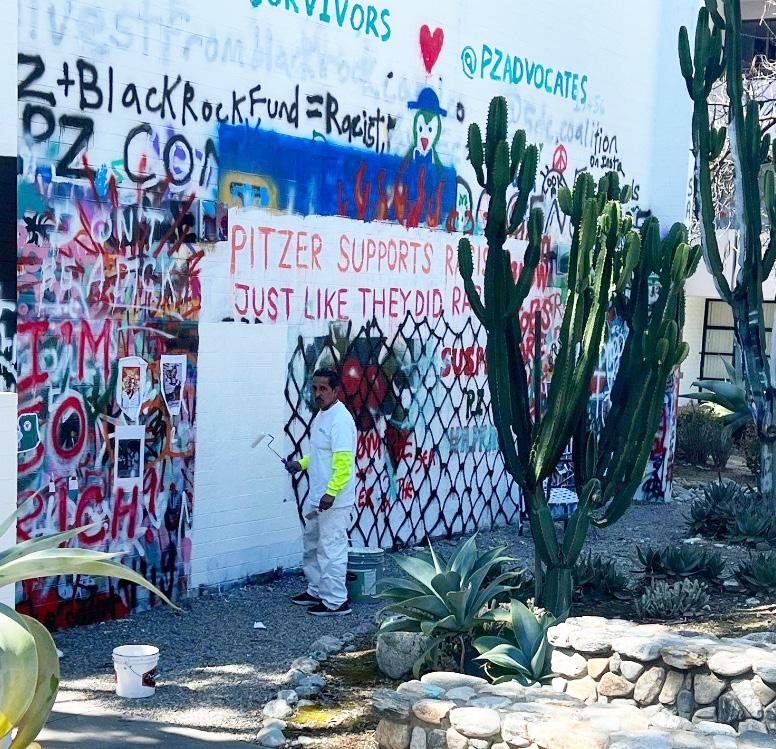
No rain, no flowers: 5C students see first superbloom since 2019

ANNABELLE INK
For the past few months, California has been covered in a vast array of colorful wildflowers, marking the appearance of what has come to be known as the “superbloom.”
of many such periods in a state characterized by on-and-off drought — California saw abnormally high levels of precipitation. This past winter, heavy rains and storms brought over 78 trillion gallons of water to the state, compared to its yearly average of 52 trillion gallons. According to the National Oceanic and Atmospheric Administration, this has effectively “wiped out exceptional and extreme drought in California for the first time since 2020.”
Along with a potential end to California’s current drought, these heightened precipitation levels have brought with them a beautiful superbloom, with important implications for the regional effects of climate change in Southern California. Meanwhile, students at the Claremont Col-

COURTESY: lUE KHOURY
SJp received faculty and student support to demand pitzer take accountability for removing artwork in support of palestine.
JAKE CHANG & NHI NGUYEN
On Wednesday, April 12, Claremont Students for Justice in Palestine (SJP) announced an April 14 event to repaint the Pitzer College Free Wall. This followed an April 11 email from Pitzer’s Vice President of Student Affairs Sandra Vasquez to Pitzer students confirming that the Pitzer administration removed pro-Palestinian artwork and messages painted by Claremont Students for Justice in Palestine (SJP) on the wall.
Following a dry period of nearly two years — one
See BLOOM on page 3





MAXINE DAVEY & MARIANA DURAN
On Monday, April 10, three Pomona College contingent faculty members sent an open letter to faculty sharing their removal from college-owned residences this summer, raising concerns about affording rent and the cost of living in Los Angeles County on their current salaries.
The letter was co-signed by Postdoctoral Research Fellow LiFang Lai, Rand Postdoctoral Fellow in Asian Studies Maddalena Poli and Visiting Professor of Chemistry Heidi van de Wouw. Lai, Poli and Van de Wouw were three of at least five faculty members to receive an email from the Pomona administration last February, announcing the upcoming end of their tenancy on May 31, due to an anticipated high volume of new tenure track hires for the 2023-2024 academic year.
In wider U.S. society, anti-palestinian bigotry — racism, to speak honestly — is normalized. And rather than pitzer being an exception to this wickedness, it is especially true at pitzer.
Prior to the administration’s repainting, the wall contained and an outline of the state of Palestine with the Palestinian flag inside of it. It also featured statements like “Suspend Pitzer Haifa,” “Free Palestine” and “From the River to the Sea, Palestine will be Free.” SJP initially spray-painted the messages on March 30, the day of their Suspend Pitzer Haifa campaign relaunch. Vasquez explained that she directed the removal following concerns from a Pitzer student and a faculty member.
Dan Segal
Palestinian symbols such as a keffiyeh pattern, an olive leaf See WALL on page 3
Letter from Pomona contingent faculty highlights struggle to find affordable housing
Four of those who received this notice are contingent faculty members of the college. This means they are not on the tenure-track and are instead on shorter contracts, often with less benefits and lower salaries.
Poli explained that the three decided to send the letter after over five weeks of attempted dialogue with several college administrators over their situation after they had received Pomona’s initial email in February.
In their letter to faculty, Lai, Poli and van de Wouw explained the difficulty of finding housing in LA County and the greater LA area with contingent faculty salaries, which are below the 2022 $66,750.00 low-income threshold set by the U.S.
lUCIA MARQUEZ • THE STUDENT lIFE
Department of Housing and Urban Development.
In their letter, the three included a chart detailing the predicted expenses if these three contingent faculty members must find new housing, including a car lease and gasoline for the new commute. According to the chart, contributions toward retirement or emergency funds would be nonexistent after expenses.
“It is the difference between seeing our salary entirely taken up by rent and utilities, and being able to afford rent while also al -
TSL COVID-19 Tracker covid.tsl.news from Apr. 1 - 7

at the 5Cs +1
+2 cases
**
Data from each of the 5Cs school’s testing dashboards at press time. Visit covid.tsl.news for historical data.
** No data reported See HOUSING on page 2

ARTS & CULTURE OPINIONS SPORTS
Written by Sophie Treadwell in the 1920s, “Machinal” is the the fourth and final production in “Inevitable Evolutions,” Pomona’s theater department season. On a highly stylized set, characters operate as cogs in a larger capitalist machine, with each actor taking on multiple roles. Read more on page 6.
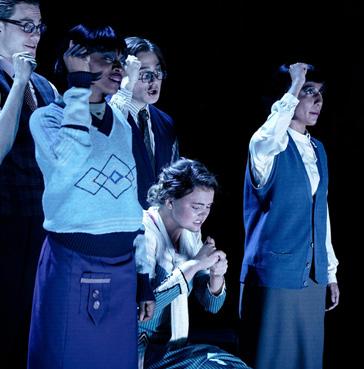
Luke Brown PO ’26 refutes a recent Op-Ed that called the government anti-youth, claiming TikTok’s potential banning should demonstrate the unregulated power of social media. Read more on page 8.

Defending their nest, the Sagehens women’s water polo team defeated the Athenas last Wednesday in the only sixth street rivalry match-up for the 2023 regular season. As the 2022 SCIAC and NCAA DIII champions, Pomona-Pitzer is in flight once again to repeat their previous success. Read more on page 9.

The student newspaper of the Claremont Colleges since 1889 INDEX: News 1 | Arts & Culture 4 | Opinions 7 | Sports 9 FRIDAY, ApRIl 14, 2023 CLAREMONT, CA VOL. CXXXIV NO. 20
GUS AlBACH • THE STUDENT lIFE
PO HMC CMC PZ SC 0 25 20 15 10 5
Student Staff Undifferentiated
+1
HMC told TSL Oct. 10 that the school will no longer post case counts on a dashboard and instead will alert students via email when there is a surge in cases. ** +0
“[The] Office of Student Affairs leadership took imme -
“I was asked to sign a contract with the understanding that I could keep housing even though it wasn’t technically written in the contract,” Poli said in an interview with TSL. “[This] has a real impact on my ability to remain in the area and to live decently.”
The term describes a rare phenomenon in which, following a remarkably dry period or prolonged drought, heavy rainfall results in an explosion of flowers across California.
In recent years, superblooms have become increasingly common occurrences, with the most recent in 2019. This increase is largely due to the impacts of climate change, which have resulted in abnormally pronounced dry and wet seasons.
Orange poppies bloom at the Antelope Valley poppy Reserve in lA County. JUlIA VICTOR • THE STUDENT lIFE
“We have probably the most modest faculty housing there: one bedroom, single occupancy and it’s $1,055 a month,” Van de Wouw told TSL. “And anything within a ten mile radius seems to be about $2,200 a month or more. So that means that our rent would at least double if we were to leave faculty housing.”
“Having housing is not a matter of attraction,” Lai, Poli and van de Wouw wrote in the letter.
FREE WALL CENSORED
P-P, CMS release athletic department budget breakdowns, reveals gender disparities
MAXINE DAVEY & JUNE HSU
Pomona-Pitzer (P-P) and Claremont-Mudd-Scripps (CMS) athletics programs both completed an Equity in Athletics Disclosure Act (EADA) report outlining the spending totals of their respective programs that were made available to the public earlier this month.
This report covered the 20212022 academic year as a result of the EADA of 1994, which requires all coeducational higher education institutions participating in federal student financial aid programs to report on intercollegiate athletic program finances. The EADA contains information regarding athletic participation, coaching salaries, team expenses and recruiting expenses. Both P-P and CMS’ EADA reports displayed general disparities in expenses between men’s and women’s teams, with both football teams’ total expenses exceeding all others for both athletic programs. P-P reported that from 2021-2022, the ten men’s teams’ total expenses were $2,097,637, while the 11 women’s teams’ expenses were $1,807,482. This disparity was less prevalent in CMS’ report, showing men’s teams’ total expenses as $2,059,314 while women’s was $2,020,439.
All P-P athletic teams receive the same per-student-athlete finances, but some factors cause certain team expenses to be higher than others, Pomona-Pitzer Director of Athletics Miriam Merrill explained in an email to TSL.
“There may be variances in the total amount spent for a team’s equipment, which may not be purchased on an annual basis. The competitive season for one sport may be longer than another,” Merrill said. “Although the budget for a given team may be different, we are committed to ongoing efforts to ensure that the total per-student-athlete spend is equitable across all teams.”
Merrill added that factors such as travel and uniform expenses are established on budget cycles, which also contributes to the differences in expenses in the EADA report. Gilien Silsby, director of news and media at Claremont McKenna College, also cited roster size, equipment and travel as factors.
Both P-P’s and CMS’ athletics budget is managed by the head of the department, while head
coaches manage their respective team budgets on a day-to-day basis. Head coaches are in communication with the department regarding these budgets, specifically large expenditures such as travel expenses. CMS Athletics’ final fiscal responsibility lies on the athletic director, Erica Jasper, according to Silsby.
As both athletic programs compete in the Southern California Intercollegiate Athletic Conference (SCIAC), a Division III conference, athletic
teams and programs do not generate revenue. Therefore, revenue does not factor into team budgets.
“Although most of our head coaches fundraise to offset the costs of travel outside of the SCIAC as well as other upgrades that improve the student-athlete experience, no CMS Athletic Programs
the number of male coaches who have been at Pomona-Pitzer over a longer period is larger than the number of female coaches who have been here just as long.”
At CMS, the average annual institutional salary per head coaching position is $50,384 for men’s teams and $65,000 for
address these disparities accordingly. “The [colleges continue] to prioritize efforts to attract and retain qualified and experienced female coaches,” she said. “Some examples include mentorship opportunities and recruiting focused on populations underrepresented in
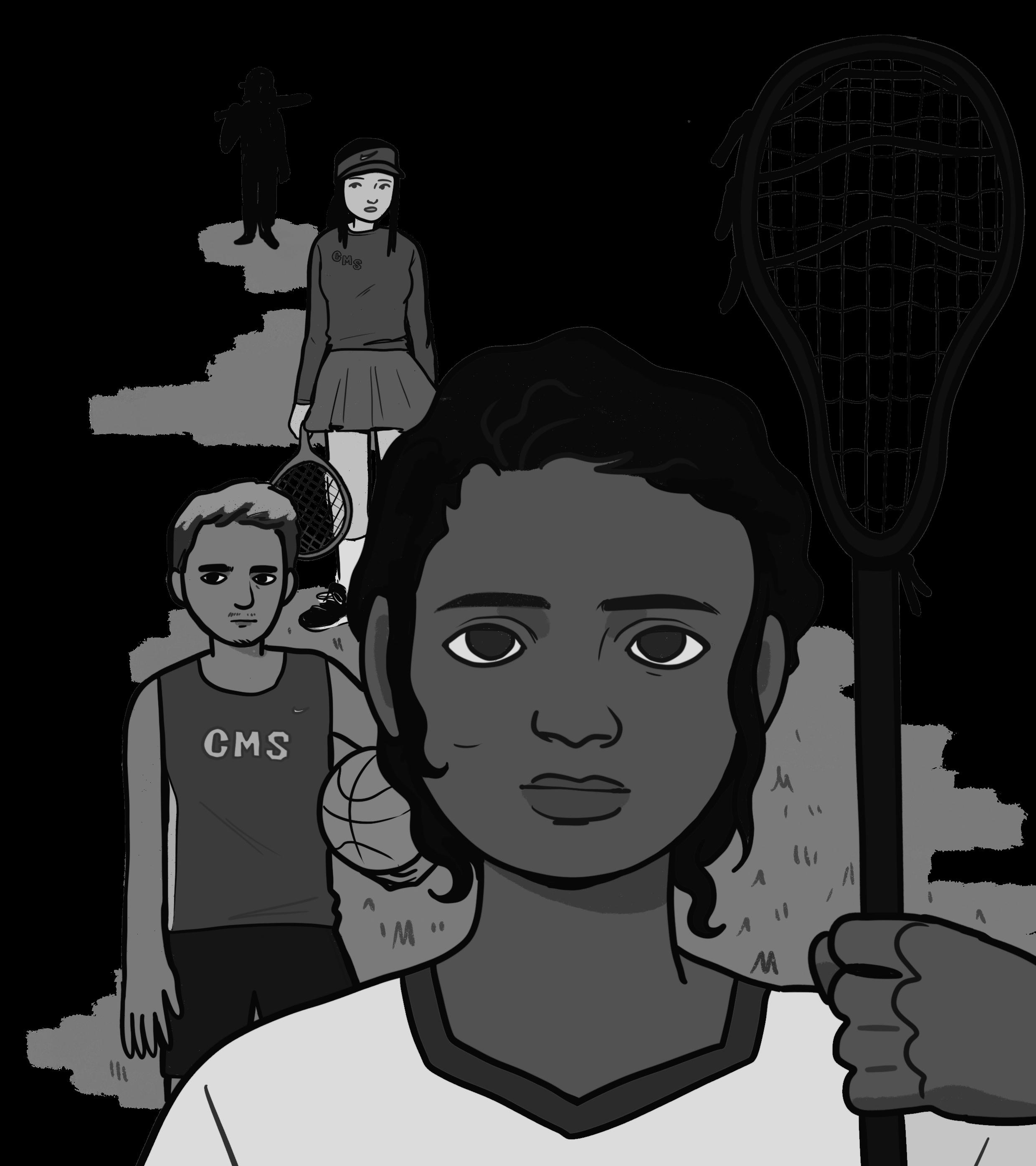
HOUSING: Five Pomona contingent faculty lose college-owned residence housing
Continued from page 1
locating money towards professional and personal goals … It is the difference between ongoing precarity and mental and financial stability necessary to perform our duties.”
Lai, Poli and van de Wouw added that they have appealed to several people in the Academic Dean’s Office about the difficulties they face. However, they were still lacking a clear response from administration.
“I didn’t hear much feedback, and it sounded like there wasn’t much feedback,” Van de Wuow said. “And so I wanted to go through my department because I felt like they would have more of a rapport and more leverage … My teaching schedule for next semester was based on me living really nearby. I thought, given that knowledge, it would be useful for my chair to kind of vouch for me. But nothing happened with that.”
Van de Wouw’s chemistry department chair, Chuck Taylor, added the department is working with Vice President of Academic Affairs Yuqing Melanie Wu’s office to come up with a solution.
“We support and value the important contributions that both of our affected visiting chemistry faculty are making and want to be able to retain them for the coming year,” Taylor told TSL via email.
Wu did not immediately respond to inquiries as to what the college was doing to address the concerns shared in the letter, as she was out of office this week.
On behalf of Wu and the college, Vice President, Chief Operating Officer and treasurer Jeff Roth told TSL via email that over the years, housing had been offered for specific periods of time to help people settle into the community.
“We currently have significantly more newly-hired tenure track faculty, post-doc and visiting faculty than we have rental units,” Roth said. “While we do not have the capacity to provide housing on an ongoing basis for all, we will continue to work to maximize the use of the housing we do have available and serve as many people as possible.”
But in their letter, the three faculty members questioned the
administration’s decision to prioritize potential incoming faculty over those who are already part of campus, wondering whether the displacement decision was made to appear more attractive to potential hirees.
“We are here. We are already here, we are working, [and] we are engaging with the students. We are already part of the community,” Poli told TSL. “But somehow we come after these potential hires. How does that come across?”
Following the publication of their letter, Poli, Van de Wuow and Lai said they received messages of support from various faculty members, who also shared their own experiences affording life as contingent faculty. These responses, Lai said, highlighted historical disparities in treatment between contingent and tenure-track or tenured faculty.
“We’ve gotten support from, I would say, more junior faculty, and some of them also said they’re in the same situation,” Lai said. “This problem has existed for years. It’s not only happening right now. So I believe
Corrections
the school needs to do something to change it.”
The three said they hope to open a dialogue about financial disparities between tenured and untenured faculty that they said exist, not just at Pomona, but in broader academia.
“We realize this is part of a much bigger conversation and we want to continue to have this conversation here at Pomona,” Poli said. As a first step in addressing some of the issues … we’re hoping that we get to stay for the reasons stated and because once we are secure, mentally and financially, then we can continue to have this conversation more meaningfully.”
Visiting assistant professor Sherilyn Tamagawa, who has not had access to college-provided housing during her time teaching at the school, told TSL she plans to leave academia due to similar financial concerns to those voiced by the three letter writers.
“[Poli, Van de Wuow and Lai] expressed a lot of fear in their letter about how they are going to pay for everything, how they’re going to find hous -
ing they can afford,” Tamagawa said. “And for me, the first thing that I thought [reading the letter] was that their fears are justified because I’ve been living that for the past two years and it has been hard to make ends meet financially.”
Tamagawa, who teaches mathematics and statistics, said that with her current salary at Pomona, she makes enough money to cover necessities but doesn’t have much left after accounting for the price of rent and groceries. Because of this lack of financial stability, she decided to stop teaching after this year and instead look for jobs that make it easier to pay for rent and more regularly visit her family.
“It was a really hard decision, and I’m still really sad about it because I love this job. I love everything about doing this job,” Tamagawa said. “I love having my students. I love having classes and advising senior theses and hanging out with my collaborators. It’s a job that I’ve wanted to do since I was [in college] and it’s a job that I think I’ve spent most of my adult life trying to be good at. But I can’t do it anymore.”
Gorelik. TSL regrets these errors.
TSL regrets the errors.
pAGE 2 ApRIl 14, 2023 Ne W s
In Issue 19, a news article misparaphrased that CSWA students and protesters blocked McConnell entrances during the boycott. It should’ve read that the demonstrators picketed outside both entrances of McConnell. Additionally, Peter Dien was credited as the author of last week’s article “So You Want to Dress: Bimbo.” The article was written by Lisa
BEllA pETTENGIll • THE STUDENT lIFE
WALL: Pitzer apologizes for ‘honest error’
Continued
diate steps to share our acknowledgement of [the] error, an explanation of how it occurred, and an apology with a concerned faculty leader, both in-person and in writing via email,” Vasquez said in the email. “Our office made an honest error, and again, I sincerely apologize.”
Pitzer Professor of Anthropology and History and proponent of SJP’s campaign Dan Segal contacted Vasquez on Thursday, April 6, confirming the adminis -
tration’s involvement after hearing about the issue. Segal shared that Vasquez explained that the student and faculty member complainants had interpreted the statement “From the River to the Sea, Palestine Will Be Free” as an anti-Semitic threat.
“I told her the truth: that that claim about that expression is a common lie of Zionist propaganda, precisely to trick people like her into censoring pro-Palestinian speech,” Segal said. “Some naïve people might even have been duped by this lie, this propaganda, and genuinely think that the phrase means that, but it’s nonsense — malicious nonsense.”
He sent an email to Pitzer faculty later that day stating that the painted over wall constituted “a grievous violation of speech rights” and targeted Palestinian-identified students.
“In wider U.S. society, anti-Palestinian bigotry — racism, to speak honestly — is normalized. And rather than Pitzer being an exception to this wickedness, it is especially true at Pitzer,” Segal said in an email to TSL. “This new censorship by the Pitzer administration hardens that normalization of anti-Palestinian racism by
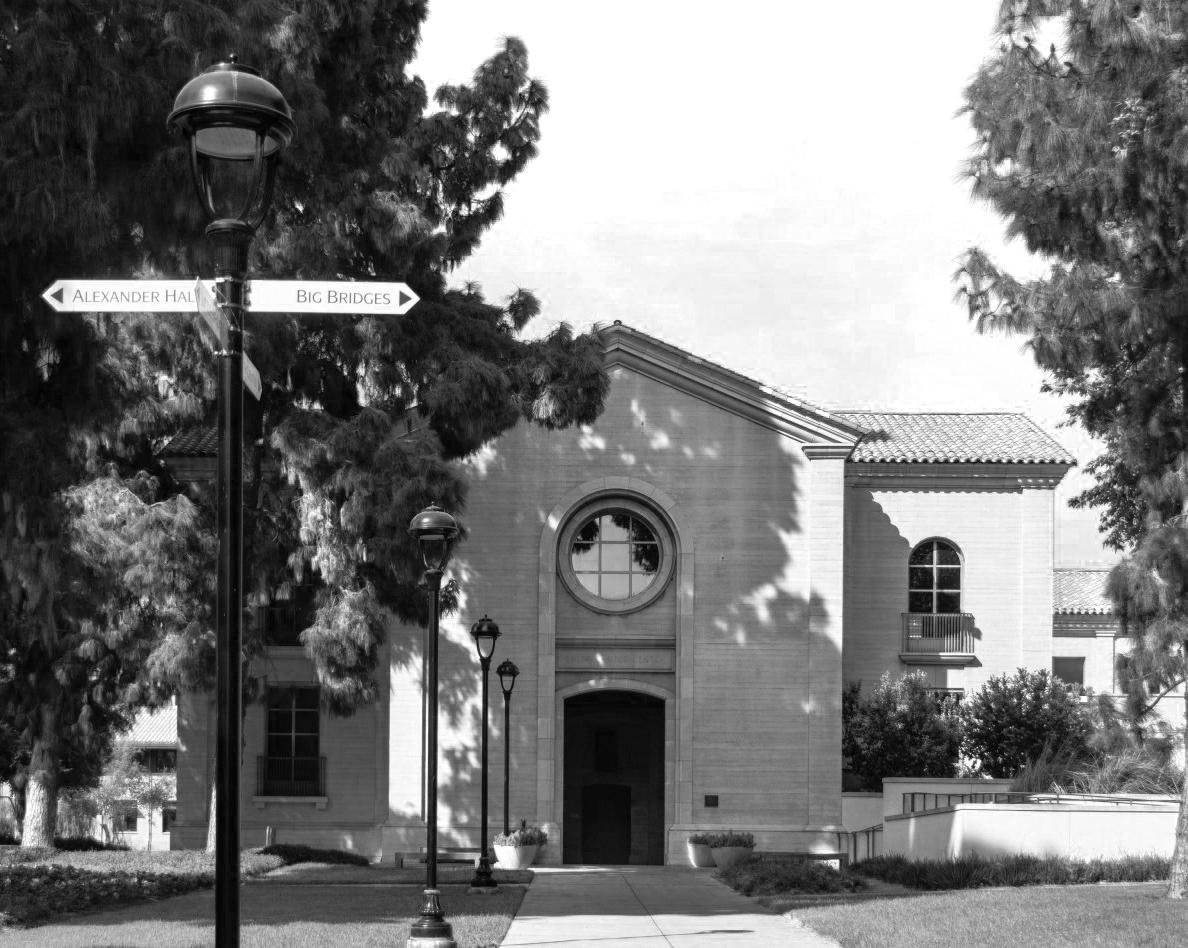

this Pitzer administration.”
SJP was not consulted prior to their artwork and messages being painted over, Palestinian student and SJP member Jacob Brittain PZ ’23 explained.
“It was a complete falling apart of the administration structure and their communication, since it was not even clearly communicated [that] when [they] do remove anything from the Free Wall, this is supposed to happen,” Brittain said.
Brittain clarified that the
“From the River to the Sea, Palestine Will Be Free” statement is a common phrase used in support of Palestinian freedom.
“Understanding the [intentions] of where [the statement] comes from is the key purpose,”
Brittain said. “I think that’s something that allows me to feel like I have a voice when I hear it or when I say it.”
Segal criticized Vasquez’s email response, sharing that the administrative apology was too abstract in mentioning the censorship.
“This so-called apology thus fails to acknowledge, and fails to accept responsibility for, the harms done by this administrative censorship to Palestinian and Palestinian-American students at Pitzer and at the 5Cs,” Segal said via email.
According to Brittain, Pitzer administration has offered to reimburse the spray paint and materials needed to reinstate the mural.
BLOOM: Winter showers bring California flowers
SJP member Evelyn Lillimoe
PZ ‘25 stated that she was not completely surprised at Pitzer’s actions given their precedent of opposing student support for Palestinian liberation, referencing former Pitzer President Melvin Oliver using two vetoes during his tenure in response to resolutions in support of Palestine.
“Pitzer has a long history of silencing student voices that are for Palestinian immigration and specifically Palestinian student voices,” Lillimoe said. “I think this act of censorship was shocking but not necessarily unsurprising.”
In reparation for the act of censorship, Brittain and Lillimoe ask that Pitzer support
their Suspend Haifa Pitzer campaign.
“If Pitzer is truly dedicated to social responsibility and uplifting student voices, then what they need to do is support our campaign to conditionally suspend the study abroad program at the University of Haifa because that is a way that we can materially contribute to the fight for Palestinian Liberation,” Lillimoe said.
The addition of the “inadequate” apology to the censorship and previous veto of the Suspend Pitzer Haifa resolution signals a broader anti-Palestinian trend, according to Segal.
“My response to this administration is this: your anti-Palestinian racism is showing,” Segal said in his April 11 email.
Code violations cause for A sPC revote
On Wednesday, April 12, Elections Commissioner Devlin Orlin PO ’25 declared Bianca McNeely PO ’25 as the new ASPC Vice President of Academic Affairs (VPAA). McNeely’s victory comes after a re-vote for the position announced to Pomona students in an email on Monday, April 10.
Orlin initiated the re-vote after the ASPC election committee found two student candidates running against McNeely in violation of the elections code. McNeely was the only one of the three campaigning candidates who did not violate the elections code.
Orlin shared that the ASPC elections committee selected from a few choices of how to proceed after finding out about the violations. “The elections committee had the options of disqualifying a candidate, holding a re-vote with a notice of the violation placed on the ballot or another action,” Orlin told TSL via text. “We aim to give voters the greatest agency, so we thought a re-vote would be appropriate.”
One of the opposing candidates was elected VPAA in the initial vote on Tuesday, April 4. This student previously
served for three years on the Academic Affairs Committee.
“[The student] campaigned using a social media account from a previous elections cycle,” Orlin said to Pomona students via email. “[The student then] misled the Elections Committee [during their investigation].”
The student addressed these concerns in a statement on a new public Instagram account used to campaign for the position.
“I mistakenly used an old Instagram account without carefully going over the code,” the post read. “After the Elections Commissioner reached out to me, I immediately made a new account and deactivated the old one. The old account was used for less than 24 hours.”
The other student named in the email from Orlin was pulled from the ASPC election because the committee found that they began campaigning before the revote was announced.
All ASPC candidates attended a presentation about the election code as per ASPC procedure on March 29. Candidates were informed that, in the case of a violation of the code, they could be publicly named.
TSL has deliberately chosen to allow the two student candidates facing disciplinary action to remain anonymous in order to avoid any further repercussions upon publication.
Students from the 5Cs are taking a break in the warm weather to visit the superbloom.
Continued from page 1
leges are making the most of the event.
Caitlin Niiya PZ ’26 visited the superbloom early in the morning to get the full experience.
Growing up in Hawaii, where the weather is relatively constant year-round, Niiya had not previously experienced anything like the superbloom.
“It’s very different … you don’t really see fields of wildflowers or different types of poppies because the climate is so different from SoCal,” Niiya said.

Phebe Mason PO ’26, originally from New Zealand, compared the superbloom at Chino Hills to Tekapo in New Zealand, which is known for its beautiful lupins.
“[In Tekapo], there are these rows and rows of lupins … it’s really beautiful, and some of the flowers [at the superbloom] reminded me of that,” Mason said. “It kind of looked like a painting with all the colors and the way they were scattered over the hills.”
For many students, visiting the superbloom was more than an opportunity to see flowers or take photos for social media — instead, it was a way to relax, unwind and connect with nature.
“I think it’s a really great thing to explore SoCal and just to get yourself situated in the larger geography of Southern California — to just take a break, unplug, and get back into na -
ture,” Emily Gao PO ’26 said. ” Mason added that the superbloom created a new incentive for students to interact with SoCal beyond the campus grounds of the 7Cs.
“Claremont can become a bit of a bubble, and although we have lots of really beautiful nature here, I think it’s really important for humans to connect with nature more,” Mason said.
REGAN RUDMAN • THE STUDENT lIFE ASpC held a re-vote for Vice president of Academic Affairs.
ApRIl 14, 2023 pAGE 3 Ne W s COURTESY: lUE KHOURY
CHASE WADE • THE STUDENT lIFE
When exploring California’s beautiful superblooms, it’s important to be responsible and to treat nature respectfully. Before visiting a superbloom location, make sure to check out state park websites to ensure compliance with park guidelines. from page 1
FIONA HERBOLD
My response to this administration is this: your antipalestinian racism is showing
Dan Segal
Claremont Students for Justice in palenstine (SJp) make plans to repaint pitzer wall, after pitzer adminstration complaints of antisemitism.
A breath of fresh ‘Air’ for the biopic genre
PETER DIEN
When I first watched the trailer for “Air,” a biopic directed by Ben Affleck about the monumental Nike shoe deal with Michael Jordan, I scrambled to see who they casted as Jordan himself. I operated under the belief that Chris Tucker would play Jordan, as he was the only actor in the main cast that somewhat resembled the NBA superstar. After a conversation with my friend about the film, along with a quick IMDb search, I found out that Jordan’s character was not shown in the film at all.
With the exception of a few throwaway lines and archival footage, Jordan’s likeness was entirely omitted from a story that would not exist without him. I was surprised to say the least; although biopics about iconic figures can be told from varying perspectives, such as telling the story of Serena and Venus Williams through their father in “King Richard,” the idea of focusing on an individual through the lens of people that believed in them is both innovative and fascinating. “Air” is therefore a breath of fresh air for the biopic genre, showing Hollywood that large-scale stories can be achieved through mid-scale budgets.
“A shoe is just a shoe until someone steps into it.”
This line is delivered by Matt Damon playing Sonny Vacaro, a former Nike marketing executive, in the second half of “Air.” A pitch to Jordan and his family, this line is the defining one of the film, displaying the mindset of Nike executives during that time and the lesson of the film as a whole. Interestingly enough, the film does not show Jordan’s reaction, instead focusing on the people that believed in him the most: his mother, Doloris Jordan, his father, James Jordan and the Nike executives that took a risk on a scrawny, six-foot-six-inch rookie from the University of North Carolina. Upon finishing the film, I began to appreciate Affleck’s detail-oriented and specific approach to Jordan’s story, or more fittingly, the story of how Jordan became an icon to all of us. I did some additional research after watching and found that Affleck had met with Jordan prior to filming the movie, asking him about any details they might have missed. Jordan insisted that his mother should be the focal point of this story, and because he owns the rights
to his own biopic, it makes sense that he would steer away from a formulaic depiction of his life and upbringing.
Perhaps it was the ability for Affleck to communicate with Jordan that made this such an enjoyable experience, both aesthetically, with classic ’80s VHS and neon spandex, and narratively, with the emotional weight of the shoe deal.
I immediately started comparing “Air” with other biopics, and this past year’s “Elvis” immediately came to mind. The director of the film, Baz Luhrman, seemed more interested in reigniting the magic of Elvis through broad strokes and accurate casting — we all know about Austin Butler’s Elvis voice by now, so no need to elaborate on that — than actually painting an image of who Elvis and the people in his life were.
Luhrman’s maximalist direc-
“Hound Dog” and a Denzel Curry song. His meta way of attempting pseudo-retribution for the Black community is overshadowed by a plot that suggests that Elvis had a positive relationship with all the Black artists of the time, which couldn’t be farther from the actual truth.
Despite the shortcomings of a biopic like “Elvis,” its traditional approach does not necessarily make it a better or worse film than “Air.” Although I prefer the fill-inthe-blank style of “Air” compared to the on-the-nose approach to “Elvis,” I understand that not every viewer will feel the same way.
Without some prior knowledge about Michael Jordan, people may question why they should care about Jordan, and especially Jordan’s shoes. “Elvis,” on the other hand, forces you to care about its subject, using the legacy and ad-
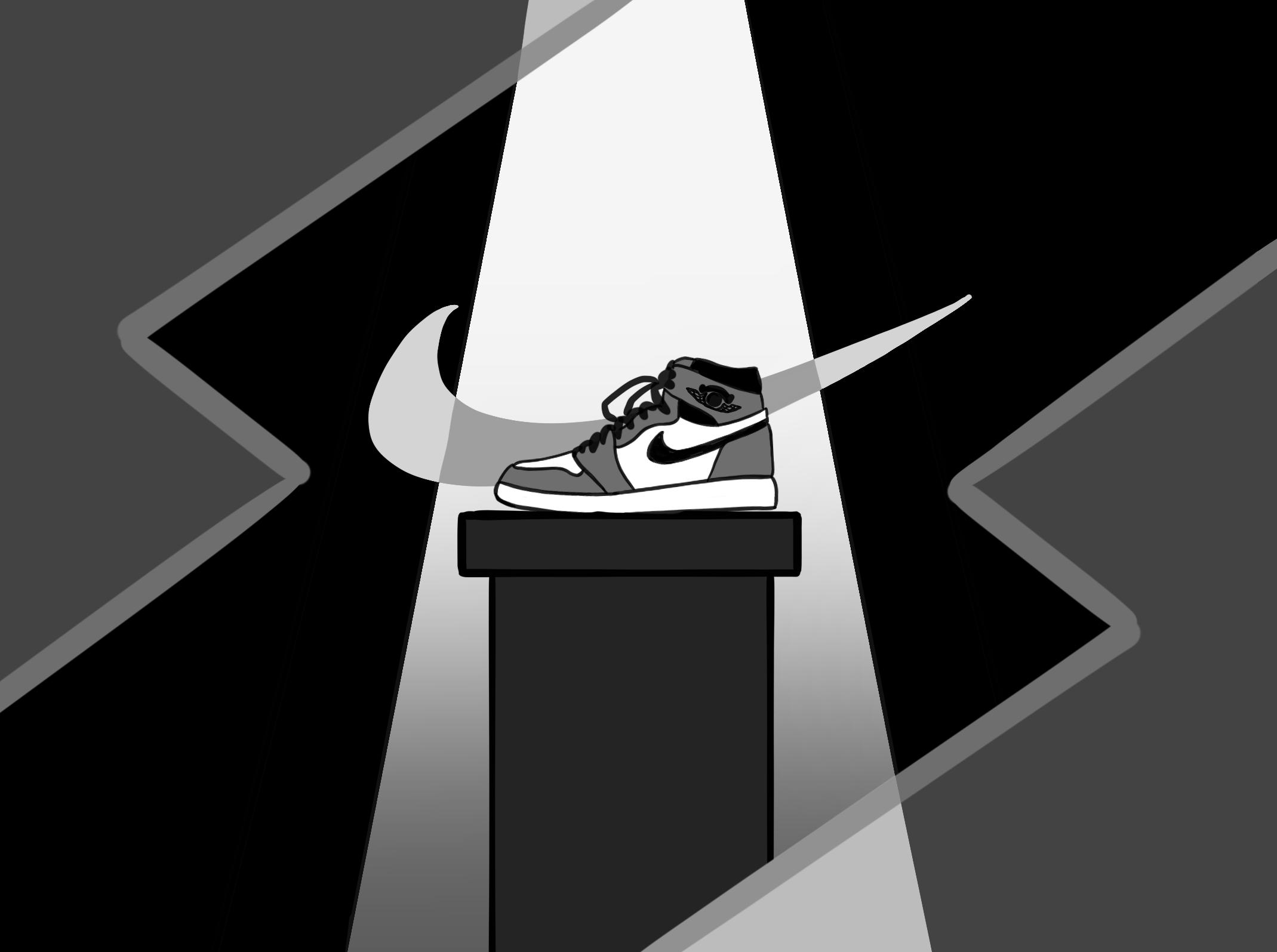
miration of Elvis in present-day to inform the iconoclastic nature of Elvis when he was coming up in the music industry.
The success of “Air,” a mid-budget drama distributed by Artists Equity, at the box office emboldens Ben Affleck and Matt Damon to achieve their goal of promoting a talent-friendly film distribution process that prioritizes creators from the bottom-up. Given that Affleck changed the spec script for this film and still managed to give full credit to the original screenwriter is a feat that is reflective of the unprecedented, player-first provisions in Nike’s shoe deal that eventually turned Jordan into an iconic representation of the American dream.
tion in “Elvis” is a stark contrast to Affleck’s commitment to historical accuracy and groundedness. “Air” touches on Jordan’s gambling addictions, his father’s death and other tragic events through montages, which serves to outline Jordan’s image in the modern context without straying away from the Nike partnership and unwavering support from his family. Luhrman doesn’t even offer a montage, glossing over the problematic elements of Elvis’ past, like him essentially stealing from Black artists and the 10-year age gap between him and his wife, Priscilla, which will be the focal point of Sofia Coppola’s upcoming biopic based on Priscilla’s memoir. In an attempt to highlight Black artists and address the racialized issues of Elvis’ past, Luhrman opts to embed modern music into this film, such as Doja Cat’s remix of r
Pizza, sex and slacking in Jean Kyoung Frazier’s debut novel
Since I was young, I’ve been a rule follower. But as I’ve gotten older, I’ve realized that I could make myself sick trying to follow the rules that tell Asians, women and queers how they should live their lives.
“Pizza Girl,” Jean Kyoung Frazier’s 2020 debut novel, blows up all those rules.
The novel follows Jane, who is 18 years old, pregnant and works as a pizza delivery girl in Los Angeles while living with her gentle, blond baseball-playing boyfriend Billy and her Korean mom.
One day, Jane gets a call from a woman named Jenny Hauser, who asks the shop to put pickles on a pizza to recreate an old favorite dish of her eight-year-old son, who refuses to eat.
Thus begins a routine that structures the rest of the book. Jenny’s calls every Wednesday for a pizza with pickles initiate a relationship between the two that is a mix of friendship, attraction, obsession and mutual understanding. I have never come across a character quite like Jane.
In an interview with Electric Lit, Frazier said that one of her goals in creating Jane was to resist stereotypes and tropes governing Asian people in fiction.
“When Asian people are portrayed in books or on the screen so sparingly and rigidly, as a kind of punchline, [they are] told that they can only be relevant by acting a very specific way,” Frazier said.
Frazier has succeeded. Jane is a mix of weird, endearing and extremely problematic.
Take, for example, her relationship with Jenny, a woman older than her mother.
It is clear that Jane’s fascination with Jenny is, as she puts it, “at least a little sexual.” When she delivers the first pizza to Jenny’s big, suburban house and sees Jenny for the first time, Jane fixates on Jenny’s long, blond ponytail. Later, she fantasizes about wrapping it around her hands and face before kissing Jenny.
Throughout the book, Jane often combines everyday occurrences with eroticism in her odd yet interesting fantasies about Jenny. Jane tells us: “I often pictured [me and Jenny] standing close but not touching, saying ‘Hey’ back and forth, her breath meaty and sour.”
Although I’ve read the book twice now, I still don’t really understand
Jane’s obsession with Jenny. But to me, Jenny seems like the white suburban mom equivalent of a manic pixie dream girl — so she has dropped out of college and has regrets and drinks and sometimes leaves her kid home alone and has a ponytail — what’s the big deal?
I personally find Jane’s fantasies with Jenny more than a little weird. But the visceral response they provoked in me, although slightly disturbing, was also why I loved them.
Frazier’s words scratched an itch in my brain, an itch I have for representations of queer sex that provoke and refuse to fit neatly in comfortable, sanitized or sanitary representations of queerness.
In Jane’s weirdness, there is freedom.
Another thing that fascinates me about Jane is that she has no plans at all for the future. When Billy asks her what she wants to do after high school, she says that she doesn’t know. Trying
to prod her into action, he asks her what she likes to do.
Jane responds: “I liked eating cereal early in the morning on the front steps of the house, seeing how sure and confident Mom’s hands moved when she folded laundry … reading under trees and watching sunlight leak through the leaves above and cast strange patterns on my skin and the pages … none of these answers were what he was looking for.”
The same interview mentioned above described “Pizza Girl” as part of the genre of “slacker fiction.” Daphne Palasi Andreades defines the genre as one in which narrators “don’t give two shits about social norms and, through their inaction, critique received notions of how we’ve been taught to exist in the world.”
Frazier said that she intentionally wanted to create a slacker who resisted the stereotype of the white man that dominates much of slacker fiction — think J.D. Salinger’s
“Catcher in the Rye,” an extremely overrated book, in my opinion.
“It may seem like no big deal, but by having slacker fiction be male-dominated, it’s perpetuating the idea that aimlessly fucking around is a specifically male thing,” Frazier said. “Even if it’s not outright saying it, what it translates to is that women are held to different standards — they exist to watch men fuck around.”
Reading Frazier’s reflection on “Pizza Girl,” I understood why I love Jane so much. Jane makes terrible decisions, does really weird, confusing things and sometimes hurts the people she loves. But so do I. So do all of us.

Growing up in my family, I was the successful child, the one who got good grades and never got into any trouble. My brother was the slacker — Don’t worry, I asked him if I could call him that and he said yes. He never liked school, preferring to get high, make music and
ride around on his mountain bike. I used to judge him so harshly. But ever since getting to college, I’ve realized that I respect him a lot. Even though some of his actions were fueled by pain and hurt, it also took a lot of courage to decide that he didn’t give a fuck about society’s or our parents’ expectations of him. Recently, in my own way, I’ve been trying to slack more — do less, watch the shadows of the leaves more. Because, as Frazier pointed out, what is slacking but refusing to follow society’s expectations of productivity and success?
Despite her many, many mistakes, Jane is still loved. In Jane, Frazier has successfully created the queer biracial Asian slacker that I, a queer biracial Asian slacker-in-the-making, didn’t know I needed.
For me, reading “Pizza Girl” was the experience of being seen, heard and healed. I can’t recommend it enough.
Reia Li PO ’24 is a gaysian wasian.
PAGE 4 APril 14, 2023 Arts & Culture
REIA LI
CHANGiNG CiNEMA EllA lEHAVi • THE STUDENT liFE
Peter Dien CM ’25 is from West Covina, California. He enjoys listening to midwest emo, watching stand-up and playing Go with his roommate.
QUEEr ASiAN rEADS
SASHA MATTHEWS • THE STUDENT liFE
Davido’s new album is a ‘Timeless’ classic
Nigerian superstar Davido recently dropped a new album, “Timeless.” This album is great — it represents a complex blending of languages, aesthetics and artists that creates a deep and influential soundscape and exposes Davido’s massive potential. Davido’s music is hard to pin down to a single genre or mood, but if one label applies to him, it’s Afrobeats. Afrobeats is less of a genre and more of an evolving stylistic trend — a blending of Yoruba rhythms and sounds with contemporary Black American sounds, from jazz to soul to R&B to hip-hop. There is tremendous diversity within Afrobeats since there are so many styles it pulls from, and the genre is evolving at an ever-increasing pace thanks to social media, taking influence from artists around the world. Afrobeats could be described as a fusion between genres as diverse as house, hip-hop, Yoruba music and highlife.
The album’s opening track, “OVER DEM,” introduces listeners to Davido with a quick saxophone solo and a strong percussion section, leading into a laid-back semi-ethereal beat with light, floaty, bubbly synths and Davido’s voice. Within the first 30 seconds of the song, the listener is exposed to a signature element of Afrobeats and Davido’s music: the blending of languages. Davido sings in three languages — English, Yoruba and Igbo — and he intermingles them throughout, creating an exceptionally smooth flow and enabling him to express himself more thoroughly than he could in a single language. Davido lyrically sets himself up as the David in a world full of Goliaths — a move that reads as a reference to the death of his son in a tragic accident a few years ago.

“UNAVAILABLE” opens with a complicated percussion section involving at least five instruments blending together to create a complex rhythmic undercurrent. The lyrics are half Yoruba and half English, but Davido is able to present such a coherent lyrical vibe that the listener can easily pick up on the emotion. The chorus sees really active and twangy drums driving the song forward into a Musa Keys feature that switches up the vocal sound while maintaining the fundamental musical feel.
On “KANTE,” Davido creates a more R&B sound while still maintaining Latin rhythms and a constant electronic presence. Nigerian singer Fave leads the song with powerful, beautiful and always-expressive vocals, backed by a strong constant
Do brain organoids dream of electric sheep?
percussive presence and a saxophone line. As she exits and Davido enters, the background track briefly backs out, making the rhythms feel even more palpable than ever when the track re-enters.
“NA MONEY” features another complicated percussion section, this time alongside classical African guitar sounds. The song features a tragically short feature from legendary Beninese singer-songwriter and five-time Grammy Award winner Anjelique Kidjo, who makes the most of her 30 seconds on the album with a stunning solo that lets her show off her incredibly expressive voice and artistic flair.
“Champion Sound” is probably the most stylistically distinct song on the album, blending the rhythms we’ve seen on the rest of the album with more of a hiphop vibe. Davido features South African rapper Focalistic who raps in Sepitori, a blend of Sesotho, Setswana and various slang that is on its way to becoming a first language. Focalistic is adept at conveying a mood and feeling through his annunciation and flow that can overwhelm language barriers. Davido is right, Focalistic is “with the Champion Sound.”
While Davido’s style isn’t exactly unique, it differs from much of American music in two significant ways. Firstly, it blends sounds and styles from around the world in such a holistic and expert way that enables global audiences to relate to and understand the musical patterns behind it.
Secondly, Davido’s constant language-switching and featuring of multilingual artists enables the album to coherently express more messages than it ever could in a single language.
I’d recommend checking out this Davido album and keeping an eye out for any new projects to which he contributes. He has undeniable talent — “Timeless” is exceptionally well-produced and reflects Davido’s exceptional ability to blend genres and languages. He shows huge potential with his occasional use of metaphor and his selection of fantastic features. Davido’s not going anywhere — and if he keeps making music like this, his celebrity will only grow.
Rowan Gray CM ’26 is from Sharon, Massachusetts. He wants you to know that all Oxford commas in this piece were violently deleted by his copy editors.
In Philip K. Dick’s 1968 novel, “Do Androids Dream of Electric Sheep,” Rick Deckard is a bounty hunter who retires androids that have escaped from human owners. Androids are robots who, despite internally having electric hardware, outwardly look like humans and seem to have many of the same cognitive processes. Deckard despairs after falling in love with one. The novel asks: where do we draw the line between human and non-human when the non-human has many — or displays many — human traits?
Maybe you’re thinking about the question abuzz lately of whether ChatGPT is conscious.
But deserving more public attention is whether — and when — human brain organoids are conscious.
In addition to modeling some of the human brain’s physical properties, these organoids can exhibit cognitive processes that neuroscientists widely deem essential to human consciousness. So, anyone who believes consciousness has a physical basis should be concerned that there is no legal framework governing just how far brain organoid research can go.
Organoids are lab-grown tissue that are structurally and functionally similar to an organ. For example, there are liver organoids, heart organoids, etc. and ones modeled after other animals, like sheep organoids. Research from 2006 finally opened the door for growing human brain organoids, but two months ago saw the biggest breakthrough in terms of future versions potentially displaying cognitive processes widely thought by neuroscientists to entail consciousness.
The study behind the breakthrough “demonstrate[s] that human brain organoids can integrate structurally and functionally with the injured adult
mammalian brain.” Meaning, the study shows that organoids can exist with physical properties that allow them to be transplanted into a physically damaged human brain and restore cognitive processes. In this case, the process they studied here was sight.
Principal investigator Hanchiao Isaac Chen told the news distribution service of the American Association for the Advancement of Science that the study is “a very solid first step” toward understanding “how organoids could be used in other areas of the cortex.”

Not all brain organoids have structures — like cortical tissue — that are associated with consciousness, nor are all of them intended to restore cognitive processes that require consciousness. For example, the phenomenon of blindsight proves that some humans’ brains can register external objects without those people ever being aware that they have seen the objects. Nevermind for now the never-ending philosophical debate over whether physical and mental things have any relation at all, or whether one or the other even exists.
“The general consensus is that organoids are not models of a brain but rather models for certain aspects of brain development,” Paola Arlotta, chair of Harvard Department of Stem Cell and Regenerative Biology, told Psychiatry Online two years ago.
Nor is there scientific consensus over which structures are associated with consciousness.
Indeed, the most recent news article to explore this question — entitled “Can lab-grown brains become conscious?” — was published in late 2020 by the news service of Nature, a leading global scientific journal.
“Because organoids don’t have a prefrontal cortex … they cannot become conscious,” said Madeline Lancaster, a developmental biologist at the University of Cambridge, to the reporter.
But Chen’s study shows us that we’re one step closer to what Lancaster said wasn’t possible.
And as Sara Reardon, the author of the Nature news article, explains, what counts as consciousness depends upon the definitions used –– so according to more loose definitions, some brain organoids may already be conscious.
Nor would all neuroscientists care even if they were to be as conscious as, say, you, reader.
Alysson Muotri, a neuroscientist at UC San Diego, told Reardon that he hopes to eventually use these organoids to “create an artificial system that works like human consciousness.”
“Studying human brain disorders without a fully functioning brain … is like studying a pancreas that doesn’t produce insulin,” he said. Although he added that he would “welcome some guidelines … [like] to use them only for research that cannot be done in any other way, to restrict the amount of pain that can be inflicted on them and to dispose of them humanely.”
“Dispose of them humanely.”
Much like how Deckard retires the androids, right?
Some bioethicists have already voiced concerns about studies like Chen’s that transplant human brain tissue into other species. But only one national science association has offered guidance so far about the ethics of brain organoid research, and that was in 2021.
And the first “comprehensive [literature] review containing key ethical concerns for brain organoid research and proposed solutions” was only published three weeks ago.
So it’s time for anyone not a scientist to consider advocating for more laws to govern brain organoid research as they become more structurally and functionally complex.
Hannah Frasure PO ‘24 hopes her philosophy of mind professor accidentally stumbles upon this article and gives her extra credit for *trying* to put knowledge into practice.
Environmental talk highlights the importance of care in a food justice context
Robert Gottlieb opened his talk on Wednesday, April 5 with a quote by Margaret Thatcher: “To be truly radical is to make hope possible, rather than despair convincing.”
Gottlieb, emeritus professor of urban and environmental policy at Occidental College, delivered a talk at the Argue Auditorium at Pomona College about his research on the framework of care-centered politics and how it can be used to restructure and transform the food system. The talk served as the second in the Philip Rundel Speaker Series within the Pomona College Program of Environmental Analysis.
Gottlieb focuses his research on environmental and food justice, care politics and power and inequality. Gottlieb is the author of numerous books, including “Care Centered Politics: From Home to the Planet,” which was published in 2022.
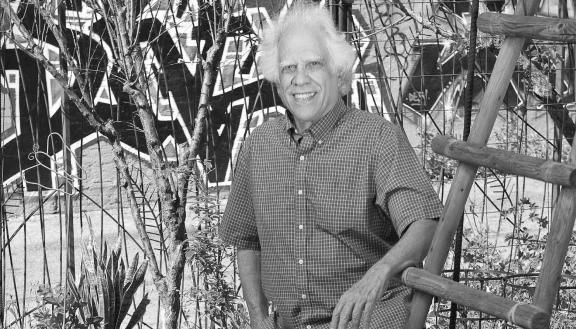
Professor Guillermo Douglass-Jaimes, assistant professor of environmental analysis at Pomona, coordinated the talk in response to student interests in food justice and care work.
“I shared some of this with a colleague of mine from Occidental College who shared that Gottlieb had a new book out that seemed like a good fit, so she made the introduction, and I invited him to give a talk on our campus,” Douglass-Jaimes said.
Furthermore, Gottlieb pointed out that his inspiration to become involved in food justice work is its ability to interweave social movements.
“Food justice is an extension of, is connected to and influences environmental justice,” said Gottlieb. “I was trying to find ways in which social movements could intersect and build capacity and … search for transformation.”
“I found Gottlieb’s connection between environmental justice and food justice interesting since activism and discourse around those topics have been separate,” Jacob Greene PO ‘23, an attendee, said.
Gottlieb conceives of the framework of food justice to examine the holistic process of the food system.
“It looks at food and the way it’s been organized through the entire process from the growing, manufacturing, marketing, selling and ultimately the disposal of food,” Gottlieb said. “[I]t looks at how and where we consume food, why we consume what we eat and how we dispose of it.”
Notably, Gottlieb mentioned that dialogue around food justice wasn’t widely shared until just a few years ago, yet it is an intersectional conversation in nature, as it encapsulates a large breadth of social issues.
“When we think about food justice, questions of labor, health, environment and immigrant rights are raised,” Gottlieb said.
A noteworthy takeaway from Gottlieb’s talk was the significance of using a care-centered approach towards issues of food justice.
“The care politics perspective is a language of healing, transformation and distribution,” Gottlieb said. The language of care aims to
redefine how we look at work and labor, race, gender issues, economics and immigrant rights in the context of the food system and beyond.
For Greene, the most resonant points in Gottlieb’s speech were ways in which we can consider a care-centered approach to think about numerous social issues today.
“I appreciated that he applied the care-centered politics lens to pressing and interconnected social issues,” Greene said. Gottlieb noted that health system dialogue reformation is closely related to care politics of challenging existing narratives.
“One of the things I argue in my book is a call for medicare, or a single-payer system,” Gottlieb said. “It’s a way to think about health not in market terms but rather in terms of who can afford a level of care.”
In a similar sense, Gottlieb explained how we can also use this care-centered perspective to reimagine policing, particularly in a post-pandemic context.
“If they’re going to be cops, maybe they should be defined differently in terms of the work that they do, and how they connect with the community, so that they stay within this care framework,” Gottlieb said.
Gottlieb also brought to light a significant objective of care politics, which involves rethinking reparations, to something not as an act of charity but as social transformation of redistribution for marginalized communities.
“Gottlieb’s talk highlighted often overlooked and undervalued care work that has always been done throughout our society and the need to value this work,” Douglass-Jaimes said.
“[C]are politics is an equal, mutualistic relationship that argues for caring with,” Gottlieb said. “The idea of care leads to action and a sense of possibility in the midst of an anti-care world.”
APril 14, 2023 PAGE 5 Arts & Culture
JULIA SKAGGS
HANNAH FRASURE
COUrTESY: OCCiDENTAl COllEGE
NEUrONAl NEWS
ROWAN GRAY
rEViEW ZONE Gottlieb,
of urban and environmental policy at Occidental College, delivered a talk at the
College on
lUCiA MArQUEZ • THE STUDENT liFE
emeritus professor
Argue
Auditorium at Pomona
April 5.
NiCOlE CEPEDA • THE STUDENT liFE
‘Machinal:’ Finding connection in a dystopian drama
“Machinal” is a play that explores the costs of human isolation and mutual incomprehension, especially across gender lines, which results in searing societal oppression and gruesome death. Yet for the cast and crew of this riveting and timely production, which opened last Friday at Pomona College’s Allen Theatre, the process of bringing such dark material to life was surprisingly joyful.
Abigail Wilson PO ’23, who is fulfilling her senior thesis as stage manager for “Machinal,” expressed that the production led to a deep sense of trust, community and connection.
“This cast really bonded quickly,” she said. “We planned so many cast hangouts or, like, [ordered] dinner beforehand or [had] a picnic … everybody cares about each other a lot which always makes a show more fun to work on.”
Written by Sophie Treadwell in the 1920s, “Machinal” is based on the highly publicized, real-life case of Ruth Snyder, a young woman who was convicted and executed for murdering her husband. The reimagined Snyder character, written simply as “A Young Woman,” was played by Kirby Kimball CM ’25. “I hadn’t done theater since I was
a senior in high school,” Kimball said. “I feel so fortunate that this was my first show back. It just kind of rekindled that spark -- that love for live performance and human connection.”
The cast attributes this sense of camaraderie in large part to Wilson and Ellie Griffin PO ’23, who is also fulfilling her senior thesis as the play’s director. “Machinal” is the fourth and final production in “Inevitable Evolutions,” Pomona’s theater department season, and is the only main-stage production to be directed by a student.
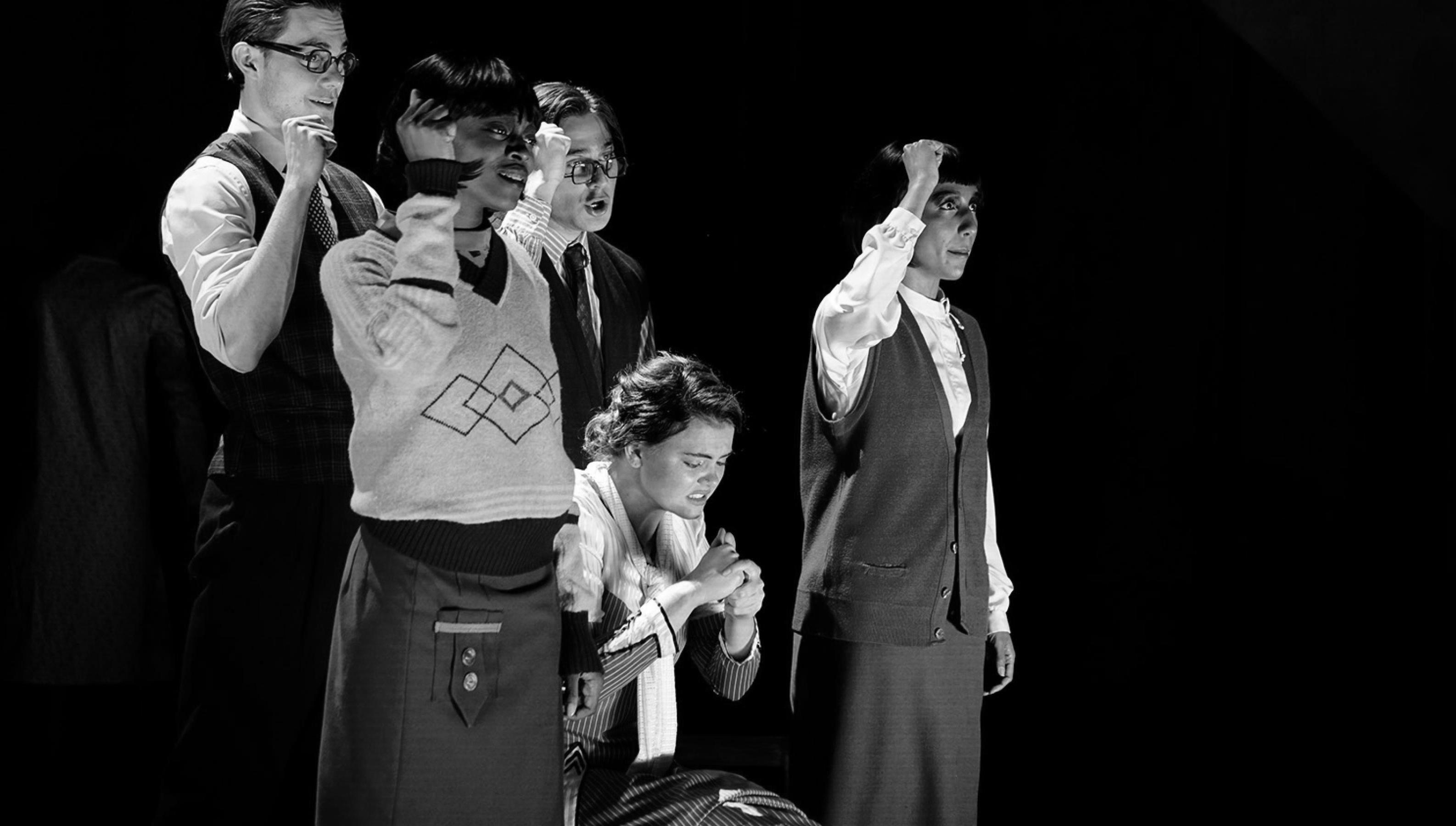
Carolyn Ratteray, associate professor of theater at Pomona and co-chair of the theater department, said that student-led productions are a valuable part of the mainstage theater season.
“These students are the future theater-makers, and the department is excited to continue to help think about, create and innovate ways to help highlight student work,” she said.
“Machinal” is highly stylized, with quick, repetitive dialogue, portraying a world where characters operate as cogs in a larger capitalist machine. The ensemble is essential to creating this mechanized society, with each actor taking on multiple roles, suggesting
people are interchangeable without enjoying any individuality. The production interweaves the actors, conjuring up a crowded subway car, for example, with nothing but a pole and their bodies.
The entirely gray, bare and modernist set creates an atmosphere of dehumanizing monotony. Lights eerily cast shadows on the blank walls, representing windows in one moment or jail bars in the next. The sounds of clacking keys, wiring motors, jackhammers, loud conversation or music sonically dominate most scenes, representing the ceaselessness and senselessness of this industrial society.
The triking costumes were the work of Monica French, the head designer and a visiting assistant professor of theater, who looked to 1920s film and art for inspiration, particularly the Expressionist and Surrealist movements. The costumes work to further isolate the Young Woman. Unlike the rest of the female cast, who appear in identical black bob wings and exaggerated eye makeup, the Young Woman is dressed in light-colored dresses and her hair is natural and brown.
“I wanted to support themes of archetypal characters, effects of
mass mechanization and how the human starts to blend with the machine,” French explained. “I also wanted to create an ensemble that seemed more automaton than human so that the humanity at the core of the lead character’s story could be emphasized.”
“I worked with Monica on streamlining the vision for the show,” Julie Morse PO ’23, who assisted with the production design, said. “I did various tasks such as putting together vision boards and sourcing pieces from rental shops.”
While the show’s costume and tech elements were purposely dated, the show’s subject matter was pertinent. The Young Woman, struggling to make ends meet and support her disdainful mother, is coerced into an unhappy marriage with her boss, who assaults and abuses her. Trapped with a child and husband she never wanted, the woman has an affair that ultimately inspires her to murder her husband in order to be free.
Caleb Brunman PO ’23, who plays the Young Woman’s lover Richard Roe, described the show as strikingly modern.
“It almost feels like a cliché to say it’s an old show but it’s still relevant today. But it is,” he said.
“I think it’s a play about autonomy, and autonomy is kind of up for grabs right now in this country.”
Kimball agreed.
“Towards the end of the show, you realize that the young woman, of course, is guilty in the eyes of the legal framework within the United States, but many factors that led her to the witness stand were not in her control,” she said. “I think the play is a larger question of the criminal justice system, and hopefully, we’ll have people having interesting conversations when they leave the theater.”
This relevance, while powerful, was also unnerving, especially in the show’s darker moments. Despite its aesthetic detachedness, the production involved audience members in scenes of graphic domestic abuse, murder and eventual electrocution by placing some of them on the edge of the stage like bystanders condoning the action or convicting members of the jury at the Young Woman’s trial. However, this physical and symbolic closeness to violence and emotional abuse left many audience members with a sense of unease.
“It definitely wasn’t what I expected going in,” audience member Sebastian and as sensitive and as powerful as it was.”
‘A Collective Memoir:’ Pitzer class showcase spotlights Asian American identities
JADA SHAVERS
In the dim Benson Auditorium, the white projection screen illuminated “Asian Americans: A Collective Memoir,” a series of ten short films exploring Asian-American stories. Consisting of a variety of different experiences, 5C students had the opportunity to view and celebrate representations of Asian identities as a community.
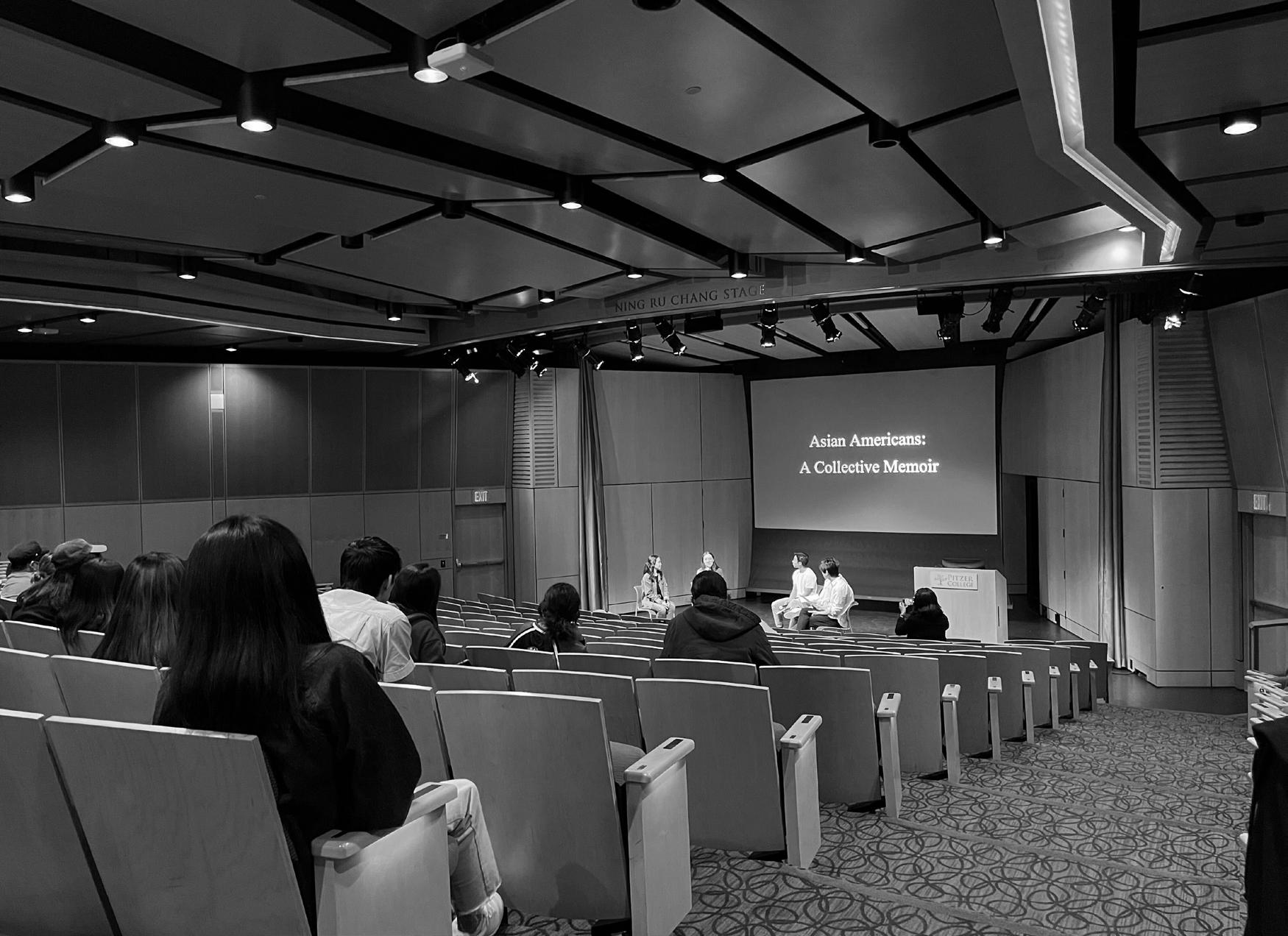
The films shown were created by Candace Ho, Dinesh Sabu, Emilio J. Virata, Iliana Garcia, Kitty Hu, Melanie Lim, Olivia Stark, Teresa Matsushima and Ziyao Liu. They varied from exploring the connection of family through food with animation from Olivia Stark to the passion of an Asian musician from Melanie Lim.
Hosted by the IMS Asian Americans in Media course at Pitzer College, students from the class curated a program shown on April 5 in Benson. Learning the processes required for planning an event, the students were able to accomplish a successful program that consisted of snacks, ten short films, guest speakers and a Q&A panel.
“I think it’s a great opportunity for all of [the students] to learn about the process of curating a show program, [and] it allows them to see a real diversity of different kinds of work,” Media Studies Professor Ann Kaneko said.
The curation was a project for the class, and roles were distributed among students to ensure that everyone played a part. The final product was a well-executed event that brought people from across the 5Cs into the space and in conversation with one another.
This collection of films was chosen by the class from the short films they had watched through-
out the semester. Each film was selected for a different reason, and the final screening was a collaborative product.
“We would look at films from the last few years ... and then as a class, decide and select the films,” professor Kaneko said.
This broad range of experiences presented brought people together and provided insights into the topics that the class discussed. One such topic was the variety of Asian-American experiences that often become generalized. To combat this monolithic conception of Asian-American identity, the class showed a variety of films with vastly different
stories.
“I feel like this event highlights a lot of different types of Asian stories,” Josh Yang PO ’23, a student in the class, said. “[I]n the media, there’s always been problems with representation for Asian stories for a lot of people because they think that Asian people are just one certain type of way and not unique in their own stories.”
The diversity of experiences presented allowed many viewers to resonate with the films. Finding elements of their identity represented in the films, the screening helped students find community.
“I very much saw my family’s stories in each of their own stories, kind of as if it was like an interweaving of Asian Americans in this country,” Robinson Lee PZ ’26, an attendee, said. Reflecting on the impact that this event had, Lee was grateful for the chance to see the films. Providing viewers the space to reflect on their identity and the chance to see other people’s interpretation in film, the screening created a unique community within the Benson auditorium.
“It was really cool to be in a community full of Asian people because you don’t really get that a lot [at the 5Cs],” Yang said.
This community is not limited to Asian-American experiences, as those interested in pursuing a career in film were able to join the space and learn from the guest speakers the class held in conversation.
The guest speakers, Melanie Lim and Olivia Stark, brought their experiences and a level of expertise that allowed viewers to ask questions about the reality of pursuing a profession in the film industry. With Lim as a video editor and Stark working in the animation field, they were each able to share helpful advice for those interested in a career in the film industry.
“I really enjoyed their stories and they had a lot of powerful lessons,” Charlie Yun PO ’23, a student of the class, said.
Following a panel hosted from students in the class, the conversation opened up to the audience.
For those uninterested in the film industry, the guest speakers provided advice for dealing with workplace discrimination as an Asian American. The speakers also opened up the space for students to come together as a community and reflect on the roles their identity plays in their life.
“A Collective Memoir,” was a celebration of Asian-American voices that brought people into conversation about identity and what it means to be Asian American in the film industry. With limited visibility on campus, students were able to collaborate and create a space for community and open conversation.
“I think these events are very valuable,” Lee said. “I think, genuinely, it’s just a good idea to have different identity groups, different ethnic groups [and] different religious groups to have their own spaces and to reflect communally.”
PAGE 6 APril 14, 2023 Arts & Culture
JO KEYSER
• THE STUDENT liFE Students from the class curated a program
April 5
JADA SHAVErS
shown on
in Benson.
COUrTESY: EMMA NEEB
“Machinal” is based on the highly publicized, real-life case of r uth Snyder, a young woman who was convicted and executed for murdering her husband.
No, TikTok regulation isn’t
A recent TSL opinion article by Rowan Gray construed the government as fundamentally anti-youth because it might ban TikTok. The greater issue, however, is not whether or not the government should regulate social media companies — it’s that the government inhibits free speech through lack of regulation.
In the absence of cultural norms, private sector happenings and other foibles, protecting free speech comes largely in the form of governmental regulation. There are numerous facets to this, but the important implication is that the government is responsible for protecting freedoms and encouraging healthy society in ways that do not conflict with guaranteed rights.
As such, it’s perplexing to analyze social media companies as valid arbiters of speech, which Gray does, when in reality it’s exactly what they do. They arbitrate speech. Algorithms select content. Prioritization of online voices is inherent to the system, particularly when companies have information about users. Age, race, political affiliations, search history, religion, birthdays, family members, device information, frequented topics and other identifiers are the dreams of any enterprising sociologist. Now give it all to some of the most powerful corporations in the world and see what happens.

But there’s a bigger problem with Gray’s argument than asking, “why do we care if the Chinese government has data about us that it got from TikTok?”: It’s the naïveté of how truly abnormal it is to never once be private in our recreation, work and daily business. Arguments about data transcend TikTok, and Gray acknowledges this by noting its availability elsewhere, namely through other social media companies selling your data. This essentially acknowledges the routine destruction of your privacy with a chipper “who cares” and whataboutism.

The op-ed meets the current occupation of our privacy with defeatism and nonchalance. Particularly bizarre and seemingly unrelated to Gray’s main argument was their demonization of older generations who perhaps own a house or enjoy the “riches” of Social Security and Medicare — programs they paid into their entire lives and are only recently enjoying the benefits of — and therefore are somehow fundamentally disconnected from us.
They aren’t missing out on much. How would their life have been substantially enhanced by TikTok in their early years? Those born in 1972 or earlier would have graduated from a four-year institution by 1997 and left the “youth culture” Gray depicts before the internet became substantially available anywhere. More accurate is calling it “youth social media content culture.” There are valid arguments from people over age 50 about regulating companies that use all your personal data to generate advertising profit. It’s ridiculous when Gray characterizes a bare majority of those over 65 who want to ban TikTok as “dinosaurs.”
anti-youth
People who don’t use TikTok are not doddering fools unfamiliar with modern humanity.
The government is not ensuring freedom of speech and exposure to ideas by letting algorithms decide what we see and hear. It is certainly within the purview of the government to take actions defending the Constitution and all its trappings; in an ideal world, youth would recognize legitimate interest in a regulatory state that prevents societal harm.
Companies today have the most information about you, not the government. Aside from necessary information for bureaucratic functioning such as birth certificates and tax records, it is companies who possess everything about you. Spending habits, interests, political leanings, location data and approval of certain content — what force has had more data to
ization, the inability for others to understand us, attention gaps and various forms of isolation. This incessant refusal, or inability, to give up instantaneous content and diversity of thought is a harbinger of future backsliding and turmoil.
Stratification and isolation of thought — the inherent fruits of social media content consumption — usually begets conflict borne of ignorance and misunderstanding. It’s agonizing to deal with problems created by rushed thinking and careless allowances.

All of this points to Congress taking on responsibility. Societal change is rapid and easily implemented, inasmuch as things quickly get worse if not corrected by some external or otherwise empowered force. I remind readers that the systemic legitimacy
The RESTRICT Act is more than just a threat to TikTok
LIAM MARTIN
Why care about the First and Fourth Amendments when your favorite social media website is on the line? This, more or less, seemed to be the main argument of TSL opinions’ staff writer Rowan Gray’s recent article on what he called the “TikTok ban.” While arguing in a positive direction, the article completely misses the point: this ban is a horrible idea because of what it would affect, the precedents it creates and the requirements to enforce it.
The TikTok ban in its most recent iteration is actually called the RESTRICT Act, an extension of the PATRIOT Act,
featist. I agree that it is preferable to have Chinese agents gather our information over American agents who can do more damage with it. I also agree that all large social media websites and their applications have enormous data collection and retention problems. But what I don’t agree with is TikTok being necessary to have a “youth culture” and Gray’s take on surveillance in general. As an aside: To remove the phrase from its double-quote prison, I’ll take “youth culture” to be whatever collection of fads and celebrities is being worshiped by people aged 10-20; I don’t know what most of these fads are, but I can safely assume that TikTok is one of them.
The article presents a defeatist and unsophisticated opinion on what surveillance is. Surveillance is already, unfortunately, commonplace, so many peoples’ already complacent views may be vindicated by the article. Even if one doesn’t care about the metadata they put out onto the internet, their actions affect others in a manner not commonly considered. Take this: You might only be looking at cat videos on website X, buying things off of website Z and surfing the web in other ways that aren’t unique or even notable. The aggregate of this information can still be used to deanonymize you and everyone else you talk to through these websites, your computer and especially your smartphone.
The comment on the Chinese government using their “massive security-state apparatus” to personally hunt you down negates the cheap and easy surveillance that China’s web scrapers and traffic sniffers already use. In fact, surveilling you barely imposes a cost for them. Yes, that should make you extremely concerned.
manipulate in the entirety of human history?
American life is increasingly synonymous with global life. The internet is unarguably a uniter, insofar as we are all united in destruction of privacy. It has also humanized and created a broader conscience of tolerance and openness to interesting things. I do not argue governmental regulation of it as being anodyne bureaucracy but rather as a necessity in preserving our abilities to exist in the benefits of a modern world while not sacrificing intellectual range. In a society with a true range of ideas introduced organically, everybody gains rounder ideological agency.
Most concerning is the intellectual gymnastics we continually embark on as youth. We downgrade threats to our privacy — noting correctly that it’s bad — but subsequently assuming it will naturally deteriorate. We then lament consumer culture, political polar-
of virtually all social progress and beneficial change in American society has been passed by Congress, signed by the president and found constitutional by the Supreme Court.
While governmental harmony is at its worst since the Industrial Revolution, it’s dangerous to universally disqualify our only regulator at a time when there must be regulation. Equally flawed, too, is perceiving the potential dissolution of a private, profitable arbiter of speech as an infringement on freedoms of expression guaranteed by the Constitution. The growth of content undermining our intellectual autonomy has gone unfettered and mostly unregulated, and blaming it on people over 50 is essentially targeting gray hair over tumors. Luke Brown PO ’26 is from Bluefield, West Virginia. They enjoy deceit and eating coal.
Jasper’s Crossword: THE CLARGUMENT
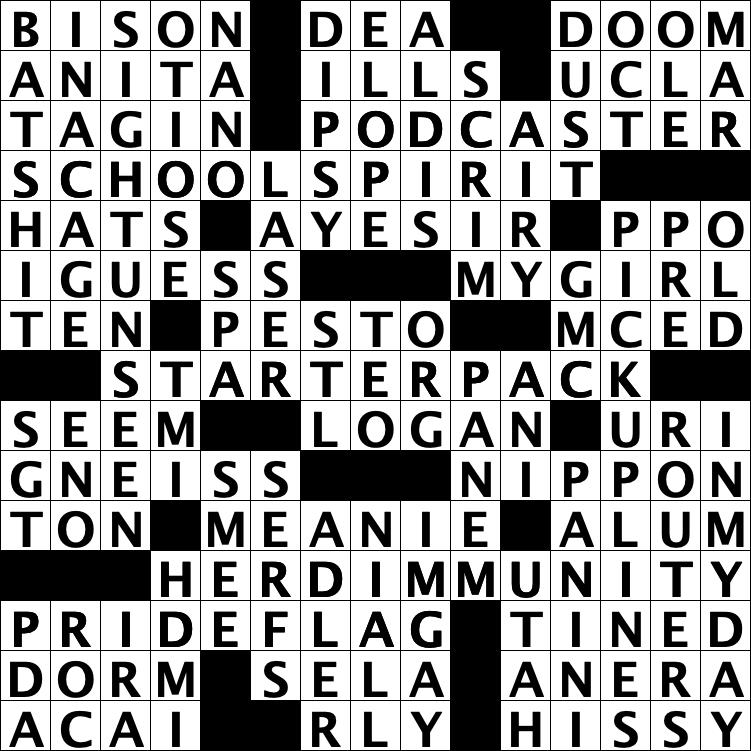
In our new feature, we ask TSL’s Instagram followers a question every Monday and share their responses here.
“Mudd, they’ll just shelter in their underground labs.”
@bellpad2021
“Undoubtedly Scripps. You do NOT want to get in a our way. We are vicious��”
@lucia_st3in
first established in 2001. The eerily named RESTRICT Act was introduced just this March and threatens more than easy access to high-volume, low-quality entertainment on a personal tracking device. The act essentially grants the Commerce Department the ability to charge individuals with up to 25 years in prison for obtaining banned software, a charge they consider smuggling.
These software are those produced by the United States’ foreign adversaries — China, Venezuela, Cuba, Russia, DPRK and Iran — and that meet any other qualifications they see fit, including restrictions on software that interferes with elections, tacked on for bipartisan brownie points.
Obtaining this software, as many young tech-literate students know, is relatively easy through Warez sharing. Warez sharing has been around since the advent of the internet and has only gotten safer and easier with proxy and VPN services, anonymizing networks and torrenting.
Yet, the RESTRICT Act sets a precedent that makes those practices even more closely monitored than before. Since the act targets companies — though not explicitly so — VPN and proxy services in the United States run the risk of having their users placed on an invasive watch list.
While Gray’s article does bring up the RESTRICT Act and its friends, the analysis regarding its effect on people is shortsighted and unnecessarily de-
This flippant take on one’s data collection also sets a precedent for governments and companies to conduct surveillance. People content with overarching surveillance for the sake of a little convenience kills expectations of privacy for everyone. It conditions the population to agree with whatever they now share with three-letter agencies and anyone else allowed to listen in. There are more people to consider than yourself when choosing whether or not to use a specific piece of corporate malware or restrictive hardware.
While nowhere near as important as the previous opinion, the argument that TikTok is necessary to have a youth culture is absurd. There have been multiple, flourishing youth cultures that have occurred and passed without the presence of harmful social media websites and user tracking. Millennials even had an internet-centric youth subculture that is currently being fetishized by today’s youth.
To anyone who has opened a book or talked to someone considerably older than they are, it should be obvious that TikTok isn’t needed. Sure it’s addictive, evident by how many people I see with their necks craned over a tiny screen walking in front of oncoming traffic, but it isn’t needed. A youth culture can exist without its youth being taken advantage of in such a nefarious way.
And if you want to talk to someone online not using any of these technologies, talk to a Harvey Mudd College student; any one of them will probably be able to tell you about getting started with XMPP and IRC.
Liam Martin HM ’24 is currently living under a rock and enjoying his dwellings. He welcomes further comments over encrypted email.
Which of the 7Cs would be most likely to win in the Hunger Games?
“Pitzer”
@cairos_ang3l
“Mudd–no rules against siege weapons in the arena” @ameliaisdoingherbest
“Definitely Mudd - it’s giving Wiress and Beetee vibes.” @saraanderson3456
“CMC is obviously the Career district” @a.nina.and.thread
“I’m definitely betting on cmc– they’ve got that killer instinct. You can’t teach that.”
@avesull
“Harvey mudd because they’ll build weapons out of nothing”
@k___eu
“Scripps, if u can get ts tix u can survive anything”
April 14, 2023 pAGE 7 Opini O ns
MAX rANNEY • THE STUDENT liFE
LUKE BROWN LAST WEEK’S ANSWERS
To weigh in on next week’s question, follow us on Instagram @TSLnews and keep an eye on our story on Monday! If you have a suggestion for a future question, send us an email: opinions@tsl.news.
@ross.ana.leal
Jasper is currently recovering from a concussion so no crossword this week :( The Snozzler wishes him a speedy recovery.
In conflating anti-Zionism with anti-semitism, Pomona administrators cause several harms
In response to TSL’s article, “Pomona, CMC release plan to address antisemitism on campus,” which report
ed on a “community message” signed by President Gabrielle Starr and Vice-Presidents Avis Hinkson and Yuqing Wu, Pitzer Professor Daniel Segal penned the following letter to the three Pomona administrators and sent it to TSL for publication.
Dear President Starr and Vice Presidents Hinkson and Wu:
Your “community message” of March 27, 2023, “regarding recent campus incidents and rising an
tisemitism in the US” raises several serious concerns.
A consistent harm of that email is that it conflates antisemitism and protest against the Israeli state, the latter of which is fully protected speech. That conflation serves to inhibit criticisms of the state and its relentless oppression of Palestinians — criticisms that are ethically urgent as well as protect
ed speech. This conflation is, moreover, a mainstay of Israeli hasbara; and too, it is a clear attack on both academic freedom and Palestinian freedom.
This harm runs through your email. To start, it occurs by your email choosing to bring together, into close rhetorical association, the noxious antisemitic flyers that were distributed several months ago in Claremont and recent acts of protest on the Pomona College campus directed at the Israeli state. Your email continues in this vein when it speaks of the acts of protest against Israel at Pomona as occurring in the context of “rising antisemitism in the nation.” Here let us also note that you pro
vide no source for your claim about “rising antisemitism.” And yet, when we try to track down the source for this meme in news accounts and so on, we find that the source is, consistently, the “annual audits” of “antisemitic incidents” compiled by the ADL.The problem, however, is that the ADL audits are malicious nonsense, as they persistently conflate antisemitism and support for Palestinian freedom — much as your own email does.
Furthermore, when we consider the actual antisemitism that has been unleashed in the US by Trumpism and Trumpism’s white supremacism (an antisemitism of which the flyers were clearly an instance), we find that that this antisemitism is tied not to criticisms of Israel and Zionism, but regularly to just the opposite: to support for Israel and Zionism. Consider, for instance, Evangelical Minister Robert Jeffress who attended the opening of the US embassy in Jerusalem in 2018 when Trump relocated the embassy. Like Trump, Jeffress celebrates Israel; but he also has preached that Jews cannot be saved because they do not accept Christ Jesus. He is, in short, an antisemite and a Zionist: a “Christian Zionist.” By contrast, in all my years (decades, now) working with anti-Zionist organizations, I have never encountered antisemitism.
Here it should seem obvious that conflating anti-Zionism and antisemitism — and the consequent “crying wolf” allegations and insinuations of antisemitism lodged at pro-Palestinian speech — also undermines the struggle against the very real antisemitism of the right, embrangled as it is today in Zionism.
All of this shows how mistaken and harmful is your email’s conflation of antisemitism and protest against the Israeli state.
Let me also address your expressed concern with the “destruction of property.” Destroying property as political protest is not something I have ever done myself, but I can see arguments that there are contexts where destroying a physical sign expressing, or a monument celebrating, hate — a statue honoring a Confederate general, say — would be an ethical act. For me, in short, this is a complicated matter, not one reducible to a categorical rule. But if the destruction of property is something the Pomona administration deplores, how is it that Vice President Hinkson, in 2019, failed to make a public statement condemning the destruction of property in the context of the trampling of constitutionally protected speech rights and academic freedom, after she had watched a security camera video of a Pomona student (now a Pomona alum) ripping down and destroying pro-Palestinian posters from my office door in Bernard Hall? Why did that “destruction of property” — why did that trampling of pro-Palestinian speech — not merit public condemnation by the Pomona administration?
Finally, your email speaks of a commitment to dialogue and announces the founding of a new Sustained Dialogue Institute. But does dialogue really need a new Institute? Why do you not just engage in dialogue? Why not just talk to faculty and students with whom you disagree? Here recall that in 2021, President Starr, Vice President Hinkson, and seven other Pomona administrators signed an earlier attack — also insinuating antisemitism — on Pomona students who had acted in support of Palestinian freedom. And yet, when I sent and published an open letter disagreeing with that attack on your own students, none of the nine ever responded to me. Let me put it this way: all you have to do to dialogue is dialogue; you do not need an Institute; and if you are not willing to dialogue with faculty and students who disagree with you, an Institute isn’t going to help. If you are genuinely interested in dialogue, let’s have lunch. On me!
But for now, let me say that as your faculty colleague, as a proud Jew, and as a supporter of Palestinian freedom, I find your “community message” of March 27 to be harmful to both the struggle for Palestinian freedom and the struggle against actually existing antisemitism. I thus urge you to publicly retract it, to begin the remediation of its several serious harms.
Looking Forward!
Daniel Segal
Jean M. Pitzer Professor of Anthropology and Professor of History
Coordinating Committee, Jewish Voice for Peace-Los Angeles
Past Fellow, Center for Advanced Study in the Behavioral Sciences
Past Secretary, American Anthropological Association
Copies: Professor Oona Eisenstadt Claremont AAUP
Turn your frown upside down, embrace your area requirements

The night before my first Theatrical Clown class, all I felt was annoyance towards Pomona College’s area requirements that forced me to take a class as outlandish as Theatrical Clown. In the end, the joke’s on me: I had no way of knowing how much I would get out of the experience. This is exactly the problem many students face when it comes to branching outside of their comfort zone for classes: once a student develops their specific interests, the area requirements too easily become an annoyance because they continue to push students toward exploration. I knew nothing about theatrical clowns prior to this course. What could a clown class possibly look like? What do I do if I’m uncomfortable performing in front of other people? The concept was incredibly bizarre to me. I allowed my preconceived notion that clowns had no depth to dictate my perception and attitude toward the eccentric course.
I’m sure I’m not alone in my judgment. The area requirements are part of the liberal arts experience and encourage students to explore an array of courses. My frustration was the same as that of my peers — being forced to oblige what many consider unnecessary requirements. But for me, Theatrical Clown has been more than what meets the eye.
I’ve come to learn that clowning is much more mainstream and universal than the public perceives it to be. The art of clownery focuses on challenging the universal need for perfection and uniformity. Clowns shamelessly display fallibility, a universal experience. Fear of failure contributes to anxiety and poor mental health. Clowns are combating this common dread of messing up through their art form.
Theatrical Clown has reframed my perspective on failure. In class, professor Ernie Gonzalez, Jr. had expressed his fear of bringing the Theatrical Clown course to Pomona College. He knew that the students
of 5Cs are high achievers that may not have the best relationship with failure, but his desire to enlighten the 5C community with the transformative life lessons clowning has to offer pushed him to take a chance. With tears in his eyes, he described how moved he was at how our class has not only absorbed but embraced every quirky lesson.
Throughout the course, my self-confidence in daily life has flourished. Within the first two weeks, I shifted from a state of nervousness in the basic actor warm-up to performing tasks that I genuinely fail at, including playing the electric guitar after never touching one. This class that began as just fulfilling a requirement has proven to me that those moments of discomfort in an unfamiliar situation are the areas where everyone experiences the most growth. I have found myself utilizing this lesson within and outside of academics — in other classes, lacrosse and job settings. I am more eager to immerse myself in experiences outside of my comfort zone. I can’t imagine that I would have looked at Theatrical Clown twice if it were not for the Pomona area requirements.
So, what does this mean for you?
Sure, maybe it won’t be a clown class, but broadening your horizons to all and any different areas allows you to find appreciation and respect for all subjects, no matter how much they deviate from your own interests.
Just because an area looks like it would clash with your own interests does not mean that you could not benefit or grow from taking time to find appreciation for it and its community.
Now instead of looking back on my arts area requirement as an annoyance, I know I will be forever indebted to the Pomona area requirements for opening my eyes to an art form I barely knew existed before this semester. So make like a clown and turn your frown upside down, so you can immerse yourself in all the once-in-a-lifetime classes we have access to.
Tess McHugh PO ’25 is from Denver, CO. She enjoys listening to Kendrick Lamar, spending time on the Kiawah Island beach and holding her cat, Cookie.
The 2010s are back in style — and we don’t need to fight it.
STELLA FANG
As a 19-year-old who lived through the early-to-late aughts and developed their fashion sense during the 2010s, I was skeptical to hear about the resurgence of this familiar style. But alas, Y2K — 2000s fashion, for the uninitiated — has reigned supreme for seemingly years now, and it makes sense that the trend cycle will be looking at the next decade for style inspiration. But are you ready for the comeback? Well, you don’t have much of a choice.

The transition from ’90s style trends to Y2K was virtually seamless, as ’90s slips over white T-shirts became catchy slogan baby tees à la Paris Hilton — I doubt that the return of the 2010s will be much different. Yes, everyone was afraid of the return of low-rise bottoms, but, now, many of the most fashionable people on and off campus — think Ms. Bella Hadid — sport micro mini-skirts and low-rise, flared pants with pride. It’s only a matter of time before 2010s fashion — including the all-too-dreaded skinny jeans — comes back in style. But no need to worry! Though I personally will be tightly holding onto my favorite baggy, wide-leg Levi’s, there are stylish ways you can start incorporating these 2010 trends into your 2023 wardrobe.
Arguably, the easiest resurfaced trend to weave into your outfit is chunky jewelry in the form of a statement necklace. I understand
the hesitation; when statement necklaces are mentioned, an image of monstrously constructed, 7-stone turquoise or coral-colored Kendra Scott necklaces come to mind — glorified collars, if you will. But the idea of the statement necklace as a single larger pendant is well on its way to global indoctrination.
Recently, on a spring break trip to San Diego, my friends and I passed a gem shop and, in a stroke of inspiration, half of them purchased leather-corded, heartshaped gemstone pendants. The almost hippie look of the pendants are a fun way to incorporate an interesting detail to your outfit. I recommend looking for glass pendants or metal heart ones on Poshmark or eBay. Brands to search: Heaven Mayhem, Brooke Callahan and Frasier Sterling.
Statement necklaces aren’t the only jewelry to have made a resurgence: Velvet chokers are coming back, and with a floral twist, no less. Overdone iterations of the Vivienne Westwood pearl choker first became popular in 2020, but a surge of fake flower ribbon chokers is making its rounds on Pinterest. The big brands are catching wind: Mirror Palais’ most recent runway show for Spring 2023 showed flowing sheer slips complemented with them as well. What makes the velvet choker unique is that it’s an accessory that you can make for yourself. Just stop by The Hive for some
ribbon and hot glue. In many ways, this floral velvet twist represents the beauty of the trend cycle; by adopting and adapting old trends, we develop a fashion culture that builds upon itself, growing stronger, bolder, and more inventive with each mutation. Brands to search on Etsy include HouseOfTooFan and EfflorescenceByXm.
The 2010s saw a wider trend of business casual as daily wear, with tight-fitting blazers, a work-appropriate tank top, skinny black pants and heels serving as an acceptable going-out look. And though I doubt many 5C students plan on opting for business
casual clothing on a daily basis, baby doll tops have become an interesting translation of the peplum top from the 2010s to now. Aside from just baby doll slips and tank tops that a lot of people — including myself — enjoy wearing, long-sleeve Hollister babydoll tops reminiscent of Elena Gilbert’s style in early seasons of the Vampire Diaries are also an easy alternative.
eBay and Depop are treasure troves for lingerie-esque babydolls. And slips over jeans don’t always look so out of place now. I would encourage experimenting!
Brands to search include Victoria’s Secret, Frederick’s of Holly-
wood and Hollister.
Of course, there are arguments to be made about the accelerated trend cycle — namely, that we should be consuming less and be more interested in developing our own personal senses of style. Decade resurgences, however, accomplish both of these things. Don’t get me wrong: I’m not arguing that everyone should adopt a new wardrobe immediately or that these are items that you must buy. But, if the idea of 2010s fashion intrigues you at all, I urge you to hop on the trend and discern your own flavor of 2010s.
Fashion is all about having fun and empowering yourself. You have the opportunity to take a risk — shying away from the trend cycle is shying away from an opportunity to get a better understanding of who you are, who you want to be and how you like to dress.
Try on a dress over your jeans, find a lingerie-esque baby doll on Ebay and Depop or even head over to American Eagle for some skinny jeans — you’ll certainly be ahead of the curve for that! Find some cool second-hand items or see if you can upcycle anything you already have in your closet. Who knows: maybe you’ll start a trend. And maybe — just maybe — we’ll see it again in the next 10.
pAGE 8 April 14, 2023 Opini O ns
-
-
-
-
STUDENT liFE
GErriT pUNT • THE
TESS MCHUGH
SASHA MATTHEWS • THE STUDENT liFE
Stella Fang PO ’26 is from Bellevue, Washington. She likes fashion and thinks her opinions are correct most of the time.
A howling good time with the Claremont Coyotes tennis club
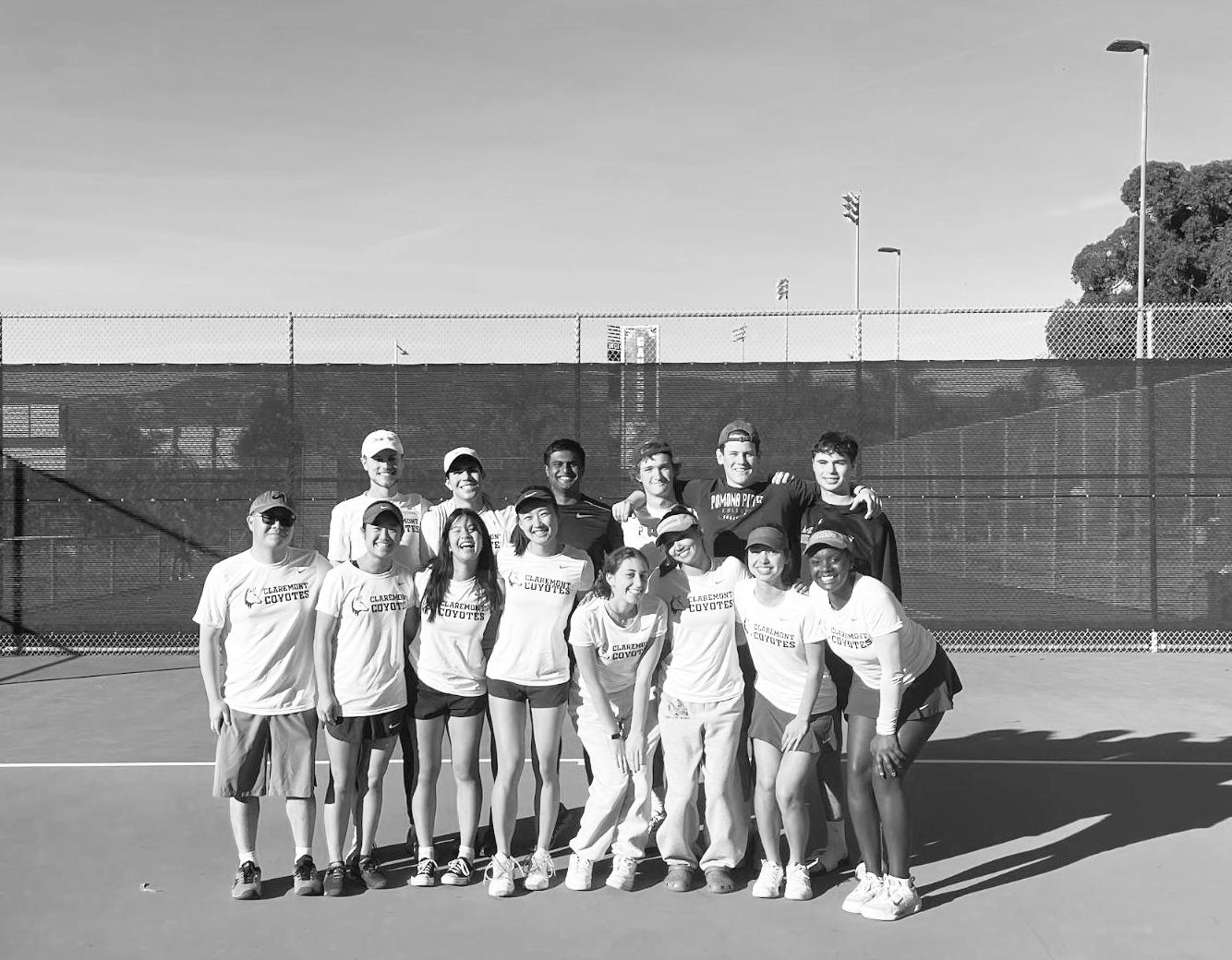
Growing up in the United Kingdom, Claremont Coyotes club tennis team captain Charlotte Cheah PO ’23 said that her high school did not have varsity sports in the same way most American schools do. Without varsity athletics, Cheah only ever played tennis leisurely in the summer and did not have a lot of competitive experience. After her first semester at Pomona College, Cheah was introduced to the club tennis team and decided to give it a try.
“I was introduced to the club through one of my friends and I thought it was such a welcoming and fun atmosphere,” Cheah said. “The first practice I went to was such a positive experience for me that I decided to join the club and use it as an opportunity to get back into the sport.”
For Sawyer Bock PO ’26, after having grown up playing tennis competitively, he knew that he did not want to be a varsity athlete in college and instead sought to find a way to continue to play the sport he loved in a more casual manner.
“Tennis used to be something that was really stressful for me,” Bock said. “[The club team] can be really relaxed and nonstressful which is something that I really wanted. At the same time because it’s all voluntary, people actually want to play when they come to practice so it doesn’t feel like a waste of time and that’s really motivating and rewarding.”
Since its founding, the team has evolved to include both a tournament team and a more leisurely, unstructured side.
While people of all skill levels are welcome to join both, Cheah explained the tournament team is a more structured entity that entails more involvement and commitment. The team holds three practices a week, two of which are unstructured and are open for all club members and anyone who may be interested in joining. Gear and equipment is provided for those who
need it. The third practice is structured and dedicated to the tournament team. Cheah said that the team only competed in one tournament in the fall, but she hopes to see this number increase in the future as schools head back to pre-pandemic norms.

“For club tennis, there was a lot of institutional knowledge that was lost over [COVID-19], and I think a lot of schools are
just now getting back into the habit of hosting tournaments,”
Cheah said.
Despite the divide between the competitive and casual sides of the team, the Coyotes as a whole are dedicated to fostering a fun and welcoming environment while also providing opportunities for everyone to play.
Alongside helping students avoid the financial investment
needed for tennis by providing equipment and courts, the club supports its members by hosting beginners workshops aimed at people who have never played tennis before. The workshops, held about once a month, are led by team captains who aim to teach interested individuals the basics of tennis.
Thomas Price PZ ’26 said that he has had nothing but positive experiences with the team. As a new member who joined the tournament team in the fall, he said that the team has been super welcoming and supportive.
“Everyone is very excited to be there and just have fun playing tennis with each other so there’s no real reason for animosities to exist,” Price said. “Everyone is incredibly supportive of each other and it’s a really positive experience for everyone … not just people who are returning to tennis, but also for those who haven’t played tennis before.”
Bock adds that he has found a new community within the team and has been introduced to some of his closest friends.
“One of the cool things about club tennis is that it creates a network of people … I’ve met a lot of older students that I wouldn’t have otherwise overlapped with,” Bock said.
By providing gear and equipment, hosting beginners workshops and not requiring any club dues, the club strives to make the sport accessible for all and encourages anyone who is interested to join and get a feel for the team.
“We really strive to provide whatever you want to get out of it. It’s really just what you make of it,” Cheah said.
P-P Women’s Water Polo defeat Athenas in dramatic Sixth Street Rivalry match
 AMALIA KOCH
AMALIA KOCH
There wasn’t an empty seat in the stands last Wednesday at Haldeman Pool.
Fans from across the consortium crowded together to watch the Claremont-MuddScripps (CMS) Athenas face the Pomona-Pitzer (P-P) Sagehens in the first and only women’s water polo Sixth Street Rivalry matchup scheduled for the 2023 regular season.
The intense, aggressive matchup was a nail-biter; P-P thwarted a near-comeback from CMS in the fourth quarter to emerge with a narrow victory, winning 13-10.
Five of the Sagehens’ 13 goals were scored by Abby Wiesenthal PO ’24, a utility player for the P-P. She said she was happy with the end result of the game.
“We had some ups and downs during that game … but we pulled out the win and that’s what counts,” Wiesenthal said.
The game started off in a deadlock and remained scoreless until CMS scored the first goal of the night halfway through the first quarter. Within less than a minute, however, P-P responded with two goals. CMS took back the lead by scoring twice before the quarter ended and the Athenas were up 3-2 going into the first break.
CMS got one more at the start of the second quarter after Cooper McKenna CM ’24 converted a 5-meter penalty, but P-P started to catch up after that. The half ended 5-4 in favor of the Sagehens after an intense scoring streak, which P-P assistant coach Elyssa Hawkins said was brought on by a specific defensive strategy.
“We knew going into this matchup, a press defense would
force pressure on their offense to make passes we could read, anticipate and steal for more offensive opportunities,” Hawkins said.
The intensity of the game remained high at the start of the third quarter, with both teams drawing lots of fouls and calling timeouts to strategize how to best take advantage of their opponents’ exclusions.
“Our biggest area for improvement following this game was in our scoring opportunities,” Hawkins said. “We especially had a lot of sixon-five extra player advantages, but we did not capitalize on all of them. That comes with improving our communication, shot selection and execution of our game plan.”
Still, P-P retained its lead throughout the third quarter, always thwarting CMS sixon-five and striking back with quick counterattacks, and the quarter ended with PP up 8-6.
The fourth quarter was by far the most intense. Early on, two players from opposing sides got tangled up in an aggressive fight for the ball and kept preventing each other from getting it after the referee blew the whistle for a foul. Not pleased with the decision, the CMS head coach protested and was given a yellow card.
P-P’s Brienz Lang PO ’26 and Paulina Correa PZ ’23 scored a goal each shortly thereafter, celebrating wildly. This only started a fire in the Athenas, however, who scored three goals in the span of two minutes — two from Isabel Del Villar CM ’26 and one from Grace Clark CM ’26 — bringing the Athenas within one point of
prepares to shoot during a match this spring.
the Sagehens (10-9) with two minutes left.
P-P’s Lulu Gaither PZ ’25 scored one more, bringing the score to 11-9, after which CMS called a timeout. Their strategizing couldn’t stop the Sagehens, though, who scored two more goals afterward. With one minute left, the Athenas didn’t have much hope of pulling out a win. Still, they fought to the end, even bringing the goalkeeper up for a seven-on-six advantage in the waning seconds of the match. Miraculously, Christina Kulick CM ’23 scored a buzzer-beater to make the final score 13-10.
Fiona Murphy SC ’26, who had one goal on the night, said the last-minute effort by Kulick was representative of the energy
she brings to the team.
“Christina … never gave up,” Murphy said. “Scoring a buzzer beater goal in the fourth quarter … I just always admire [her] effort, talent, and leadership in the pool.”
Clark said that losing in such dramatic fashion was tough for the Athenas but that they are trying to take away some positives from it.
“The result of [the] game was disappointing for our team,” Clark said. “But the loss has brought us closer together and is motivating us to work harder in the last few weeks of the season.” Hawkins said the Sagehens are using this win to propel them into the postseason.
“With the win, we close
COUrTESY:
in on solidifying our spot as regular season champions and the No. 1 seed in the postseason tournament,” Hawkins said. “We are the defending SCIAC Regular Season, SCIAC Tournament and National Champions, so one of our goals is to repeat all those titles.”
After their Saturday 22-3 win over Caltech, the Sagehens remain undefeated in SCIAC Conference play, with three conference games to go before the postseason tournament starts on April 28. The Athenas won their Saturday match against Redlands 9-3. Their loss to P-P was their first in conference play. With their dominant conference performances, both teams expect to face each other again in their battle for the SCIAC tournament title.
April 14, 2023 pAGE 9 Sport S
AUDREY SAWYER
hoping to bring casual and competitive
With equipment and court time provided, the Claremont Coyotes are
tennis to everyone at the 5Cs.
COUrTESY: CHArlOTTE CHEAH
Brienz lang pO ‘26
CMS ATHlETiCS
Known as the most expensive club sport on campus, men’s lacrosse is hoping to change their image
HAROLD FUSON
At the 5C Club Fair each fall, the Claremont Cougars, Claremont’s men’s club lacrosse team, can be seen advertising their club along with countless others. However, the $700 per semester price tag attached to the team has provides an inherent barrier. In a sport with a history of financial inaccessibility, team captain Bryce Kelly PO ’23 and faculty advisor John Faranda are acknowledging this issue and are working to make the team more inclusive for all members of the Claremont community.
Club sports at the 5Cs offer an opportunity for students looking to continue their athletic careers at the collegiate level outside of varsity athletics. Among the benefits of club sports is a relatively affordable price to be a member of the team. Although many teams do require a fee of some kind at the beginning of each season, those costs remain relatively low.
The women’s club soccer team, for example, only asks for a $25 charge which covers all costs for the remainder of the academic year.
The Claremont Braineaters, the 5Cs’ men’s ultimate frisbee team, ask their players to pay $100 for uniforms (a fee only required once in four years), as well as the cost of a plane ticket to compete at the National Tournament if the team qualifies. The team does take an optional annual spring break trip to Mexico, which costs $550 in full, but according to club member Isaiah Curtis PZ ’26, for those who need financial assistance for the trip or uniforms, the team is quick to offer it as necessary.
“I can ask for mutual aid [for whatever I need],” Curtis said. “I have gotten $52 in help with jerseys and $100 in help for the Spring Break trip.” It should be noted that this financial aid comes from a mutual aid fund, not funding directly from the colleges.
Athletes of the Week
Meanwhile, the initial fee or sticker price for the Claremont Cougars, the 5Cs’ men’s lacrosse team, is a daunting $700. In a sport often criticized for its exclusionary history, this steep cost may easily discourage some students from even going to the team’s tryouts. The cost of equipment alone has provided a barrier for even youth lacrosse, and families with a household income of over $100,000 have made up 60 percent of lacrosse players in the past 10 years.
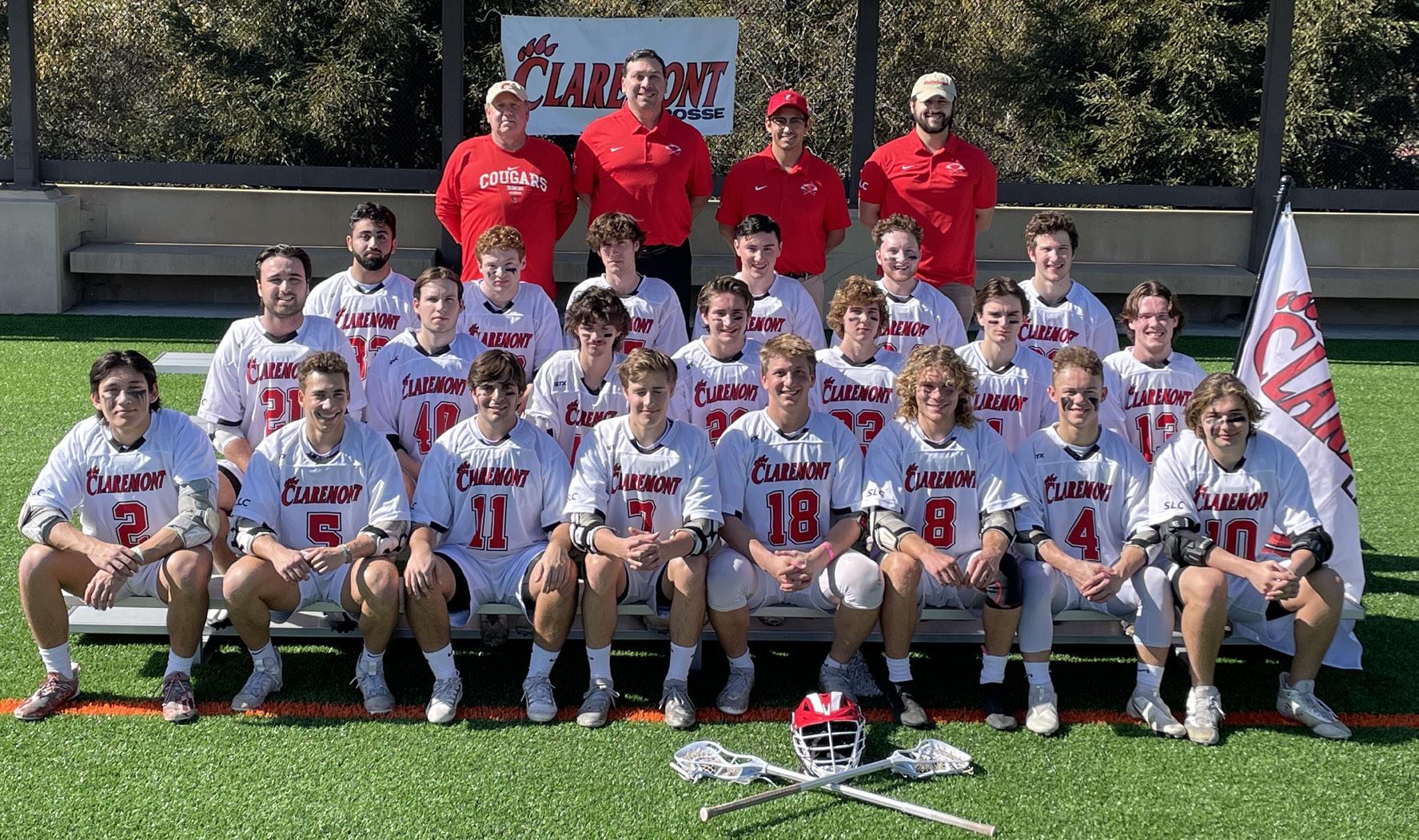
Without a varsity or intramural alternative for men’s lacrosse at the 5Cs, one could question the necessity of a steep price tag and what these dues are financing. If other club teams achieve fun and competitive seasons each year at a fraction of the budget, what justifies such a cost?
Competing as a club Division II athletic program and as a member of the Southern California Lacrosse League, the team has to travel to play teams as far away as Arizona and Nevada in order to remain a member of the conference. Travel dues as well as hotel rooms and other housing costs are a leading cause of the expensive fees.
“Unless the guys were just to stop playing away games, the road trips are quite expensive. We have to go to Arizona to play [Northern Arizona and Arizona Christian] … every other year … As long as we’re doing that, there’s really no way around having a pretty expensive team,” Faranda said.
Being a member of their conference adds even more in league dues.
“We also pay for the referees who are at the games and do a lot of the logistics there,” Kelly said.
The Cougars also have multiple coaches on payroll. Whereas the Claremont Coyotes, the 5Cs’ fully free to play coed club tennis team, are self-coached, Kelly explained the Cougars’ professional coaching staff runs up the club’s price tag.
“A lot of [the fees go] towards
coaching pay,” Kelly said. “They spend a lot of their free time driving a long the way and coming over and coaching us and hosting practices, and interact[ing] with the league as well.”
According to Faranda, in comparison to other club sports the Cougars reportedly get very little funding from the Claremont Colleges in proportion to how many students from each school are represented on the team.
“This year, the Pomona [College] student government gave the team zero dollars. I think the [Claremont McKenna College] student government gave the team $4,500,” Faranda said. These funds are not nearly enough to begin to support the team financially, so in addition to the players’ dues, the club is working to find additional ways to raise money.
“We’ve raised the fundraising
Claremont-Mudd-Scripps
Caroline DelVecchio SC ’23 earned the title of SCIAC Track Athlete of the week after competing in the Triton Invitational last weekend hosted by UC San Diego. DelVecchio came in first in the 400-meter hurdles, winning the event by 0.2 seconds, and finishing with a time of 1:01.43. DelVecchio also finished eighth in the 100-meter hurdles, ending with a time of 14.65. This is the second time this season that DelVecchio earned this honor, the first was on March 6, after an impressive performance at the first SCIAC dualmeet. This season of success is not unexpected for DelVecchio, who currently holds the CMS program record in the 400-meter hurdles, with a time of 1:00.65, and also ranks third in the 100-meter hurdles, with a PR of 14.50. CMS will run in several events this week and will be back in action as a full team when it hosts the third SCIAC Multi-Dual this Saturday.

Women’s Track & Field
Friday, April 14
Men and Women’s Track and Field @ Mt. Sac relays
Men and Women’s Track and Field @ Bryan Clay invitational
Softball Vs. Chapman
Saturday, April 15
Men’s Track and Field @ Mt. Sac relays
Men and Women’s Track and Field SCiAC Dual Meet #3
Women’s Water polo @ la Verne
Softball @ Chapman
[in recent years]. We’re just so fortunate that there’s a couple of alumni and parents out there who really are the major funders of the team,” Faranda said.
Through this external funding, Kelly and other members of the team are hoping to make the team more inclusive.
“We don’t want people to feel like they can’t participate in team activities because it might be too expensive,” Kelly said.
The Cougars work with both parents and alumni to create financial aid packages for players who need them. Faranda leads the financial aid affairs for the team.
“The team [will] find an alum or parent or someone who will fund the dues for [anyone who says they are not able to afford them],” Faranda said. “I’ve been working with the team for at least 30 years on this, and as far as I know, no one’s ever said they’re not playing because they can’t afford it.”
Discussions of financial aid have the opportunity to become an awkward conversation, especially with ones’ teammates and peers. To avoid discouraging players from reaching out to discuss aid packages at all, Faranda and Cougars head coach Scott Witkin clearly lay out that aid is available upon discussion in an email sent to all players and families prior to each season.
“As usual, if this payment will be a hardship for you and your family, let’s discuss,” Witkin and Faranda wrote.
By leaving these discussions to the coaching staff, the team is working to allow players to be transparent about the help they need.
Faranda and the Cougars’ leadership are continuing to work to make the team more accessible. As fundraising efforts increase, they hope to offer more aid to those who need it, propelling the Cougars to remain a competitive and reachable environment.
pomona-pitzer
John Kim
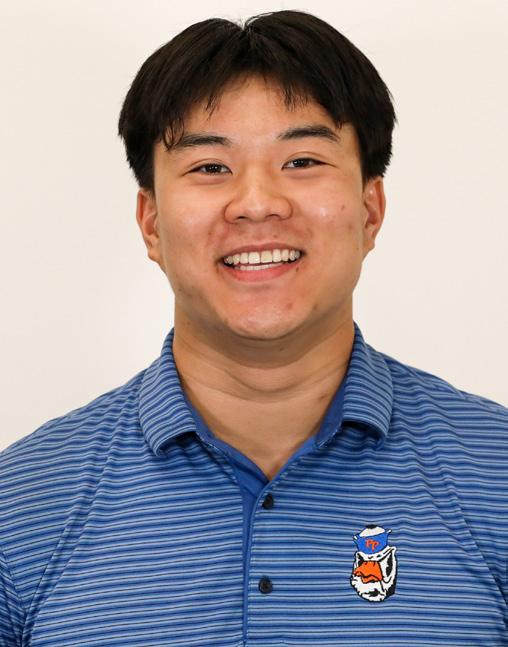
Yakima, WA
Men’s Golf
lacrosse @ Whittier
John Kim PO ’26 led the Sagehens last weekend at the Illinois Wesleyan Invitational. The match took place at the Ironwood Golf Course and the Weibring Golf course and through the help of Kim, the Sagehens finished with a tie with Lake Forest College for sixth place. Pomona-Pitzer ended the twoday tournament with a final score of 607, just 11 strokes more than Wisconsin Eau Claire, who finished fifth. Kim ended the tournament by tying for 13th place overall with an ending score of 148. He had a birdieless round to start the weekend at Ironwood Golf course, but finished there at 77 (+5) after sinking 14 pars. Kim started +2 at Weibring but pulled it together and came back to finish with a score of 71 after managing four birdies. Coming to the end of his first season as a Sagehen, P-P had high hopes for Kim who was a two-time State Champion qualifier, three-time Sporthaus Athletic Convention Award Ceremony nominee and a Sporthaus Athletic Convention Ceremony award winner. The Sagehens will travel down south to compete at the Emory Spring Invitational at the beginning of next week.
lacrosse Vs. Chapman
Sunday, April 16
Women’s Tennis @ Cal lutheran
pAGE 10 April 14, 2023 Sport S GRACE SAUERS, Production Editor EMMA CONSTABLE, Production Editor KYLIE MIES, A&C Designer PAUL YAN, Opinions Designer SELINA LU, Sports Designer JULIA VICTOR, Copy Chief DANIA ANABTAWI, Copy Chief CHASE WADE, Photo Editor WENDY ZHANG, Photo Editor BELLA PETTENGILL, Creative Director SASHA MATTHEWS, Graphics Editor SARA CAWLEY, News Editor MAXINE DAVEY, News Editor JAKE CHANG, News Associate INDIA CLAUDY, Arts & Culture Editor TANIA AZHANG, Arts & Culture Editor EMMA NEWMAN, Arts & Culture Associate ABBY LOISELLE, Opinions Editor ELENA TOWNSEND-LERDO Opinions Editor BEN LAUREN, Sports Editor ANSLEY WASHBURN, Sports Editor JENNA MCMURTRY, Special Projects Editor ANURADHA KRISHNAN, Special Projects Editor ANNIKA WHITE, DEI Editor MANAN MENDIRATTA, DEI Editor HALEY WEBB, Business Manager CLARE A’HEARN, Social Media Manager YAHJAIRI CASTILLON, Social Media Manager KANA JACKSON, Multimedia Editor SEOHYEON LEE, Web Developer SIENA SWIFT News Editorial Assistant MARIANA DURAN News Editorial Assistant THE STUDENT LIFE HANNAH WEAVER, Editor-in-Chief AVERI SULLIVAN, Managing Editor GERRIT PUNT, Managing Editor TSL’s Editorial Board consists of the editor-in-chief and two managing editors. Aside from the editorial, the views expressed in the opinions section do not necessarily reflect the views of The Student Life. Single copies of TSL are free and may be obtained at news stands around campus. Multiple copies may be purchased for $0.47 per copy with prior approval by contacting editor@tsl.news. Newspaper theft is a crime; perpetrators may be subject to disciplinary action as well as civil and/or criminal prosecution. Editorial Board Senior Staff Sports Calendar CMS P-P Friday, April 14 Men and Women’s Tack and Field @ Mt. Sac relays Men and Women’s Track and Field @ Bryan Clay invitational Women’s Tennis Vs. UC Santa Cruz Baseball Vs. redlands Softball Vs. Whittier Men’s Tennis @ Caltech Saturday, April 15 Men and Women’s Track and Field SCiAC Dual Meet #3 Men and Women’s Tennis @ Chapman Women’s Water polo @ Occidental Baseball @ redlands Softball @ Whittier
PO ’26
DelVecchio
Caroline
SC ’23 Ojai, CA
The Claremont Cougars will be hosting the first round of the NCAA Division II Playoffs on April 22 at the Pomona College South Athletic Field.
COURTESY: CLAREMONT MEN’S LACROSSE

































 AMALIA KOCH
AMALIA KOCH


